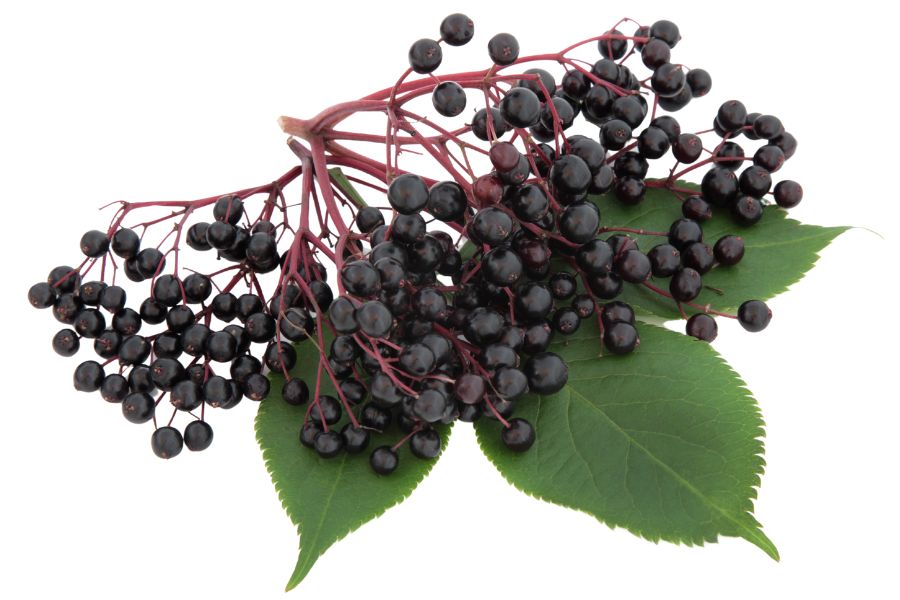New York’s forests and parks are home to a wide range of edible plants waiting to be discovered. Wild leeks, also called ramps, come up in shady woodlands and fill the air with their strong scent. In sunnier spots, you can often find mulberry trees dripping with ripe fruit.
Even places that seem ordinary can hide valuable wild foods. Cattails grow thick along the edges of ponds and marshes, offering several edible parts depending on the season. Purslane also thrives in disturbed ground, its juicy leaves standing out if you know where to look.
Knowing a few of these edible plants can turn a simple walk into something much more rewarding. Once you learn to recognize them, it’s easier to come across a surprising mix of wild foods. Being able to spot the right plants can lead to a much more abundant foraging trip than you might expect.
What We Cover In This Article:
- The Edible Plants Found in the State
- Toxic Plants That Look Like Edible Plants
- How to Get the Best Results Foraging
- Where to Find Forageables in the State
- Peak Foraging Seasons
- The extensive local experience and understanding of our team
- Input from multiple local foragers and foraging groups
- The accessibility of the various locations
- Safety and potential hazards when collecting
- Private and public locations
- A desire to include locations for both experienced foragers and those who are just starting out
Using these weights we think we’ve put together the best list out there for just about any forager to be successful!
A Quick Reminder
Before we get into the specifics about where and how to find these plants and mushrooms, we want to be clear that before ingesting any wild plant or mushroom, it should be identified with 100% certainty as edible by someone qualified and experienced in mushroom and plant identification, such as a professional mycologist or an expert forager. Misidentification can lead to serious illness or death.
All plants and mushrooms have the potential to cause severe adverse reactions in certain individuals, even death. If you are consuming wild foragables, it is crucial to cook them thoroughly and properly and only eat a small portion to test for personal tolerance. Some people may have allergies or sensitivities to specific mushrooms and plants, even if they are considered safe for others.
The information provided in this article is for general informational and educational purposes only. Foraging involves inherent risks.
The Edible Plants Found in the State
Wild plants found across the state can add fresh, seasonal ingredients to your meals:
Purslane (Portulaca oleracea)
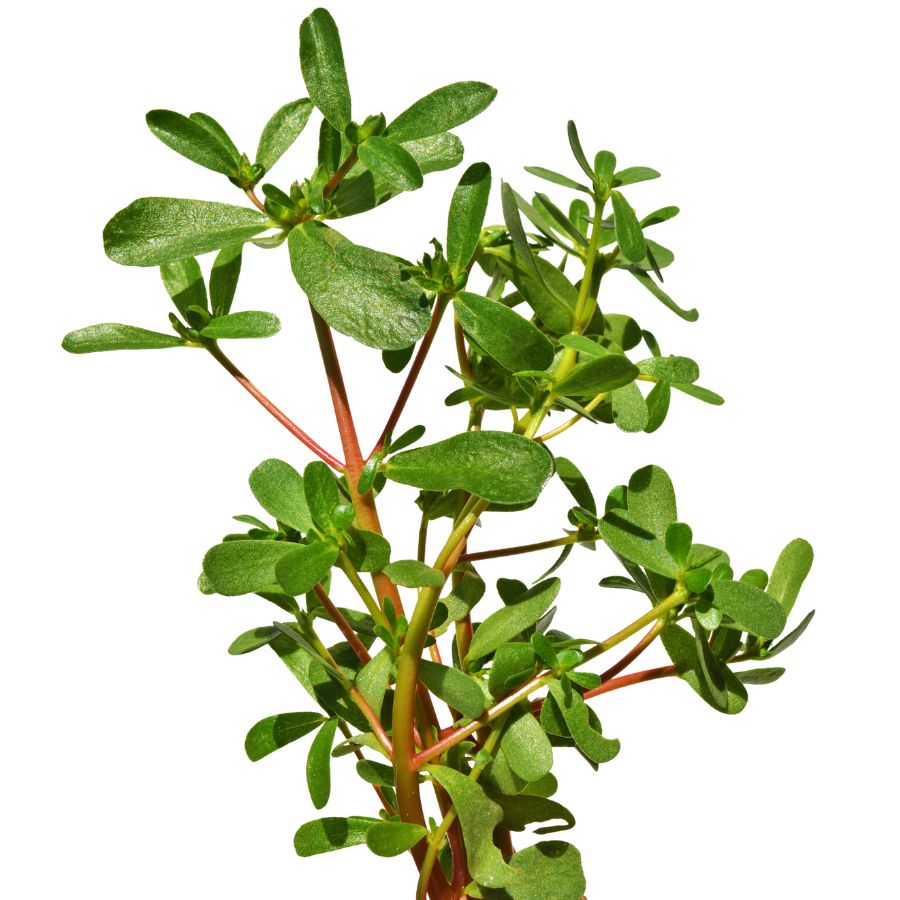
Purslane is a hardy, low-growing plant that’s also sometimes known as little hogweed or verdolaga. It has smooth, reddish stems and thick, paddle-shaped leaves that feel a bit waxy when you touch them.
The stems, leaves, and tiny yellow flowers are all edible, while the roots are not typically eaten. Purslane has a crisp texture with a slightly tart, lemony flavor that works well raw or cooked.
Some plants that look similar include spurge, which has a milky sap and is not edible, so it is important to check for purslane’s smooth, succulent stems and lack of sap. Always double-check by gently snapping a stem to make sure no white liquid appears.
You can toss fresh purslane into salads, sauté it lightly like spinach, or pickle it for later use. Its mild tartness and slight crunch make it a refreshing addition to sandwiches, soups, and even stir-fries.
Lamb’s Quarters (Chenopodium album)
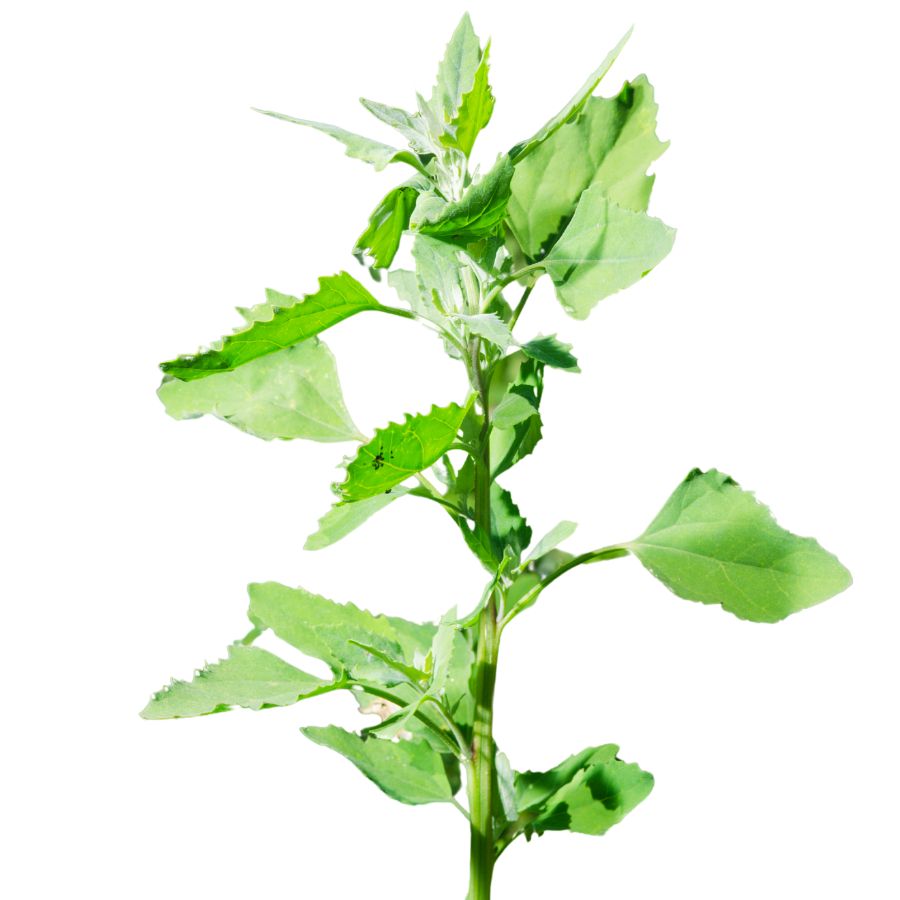
Lamb’s quarters, also called wild spinach and pigweed, has soft green leaves that often look dusted with a white, powdery coating. The leaves are shaped a little like goose feet, with slightly jagged edges and a smooth underside that feels almost velvety when you touch it.
A few plants can be confused with lamb’s quarters, like some types of nightshade, but true lamb’s quarters never have berries and its leaves are usually coated in that distinctive white bloom. Always check that the stems are grooved and not round and smooth like the poisonous lookalikes.
When you taste lamb’s quarters, you will notice it has a mild, slightly nutty flavor that gets richer when cooked. The young leaves, tender stems, and even the seeds are all edible, but you should avoid eating the older stems because they become tough and stringy.
People often sauté lamb’s quarters like spinach, blend it into smoothies, or dry the leaves for later use in soups and stews. It is also rich in oxalates, so you will want to cook it before eating large amounts to avoid any problems.
Plantain (Plantago major, Plantago lanceolata)

Plantain, also called common plantain or narrowleaf plantain depending on the type, is a low-growing plant with broad or lance-shaped leaves and tall, slender flower spikes. The leaves grow in a rosette close to the ground, and the thick veins running through them are one of the easiest ways to tell it apart from other plants.
You can mainly eat the young leaves and the seeds of the plants. Older leaves can become tough and stringy, so it is best to pick the smaller, tender ones when you want to eat them.
Plantain leaves have a slightly bitter, earthy taste and a chewy texture, especially when eaten raw. Many people like to add them to salads, soups, or stews, or lightly steam them to soften the flavor.
Always make sure you have a true plantain before eating because some similar-looking yard plants are not palatable and can upset your stomach. Look for the strong parallel veins and the tough, fibrous stems to help confirm your find.
Blueberry (Vaccinium corymbosum, Vaccinium angustifolium)
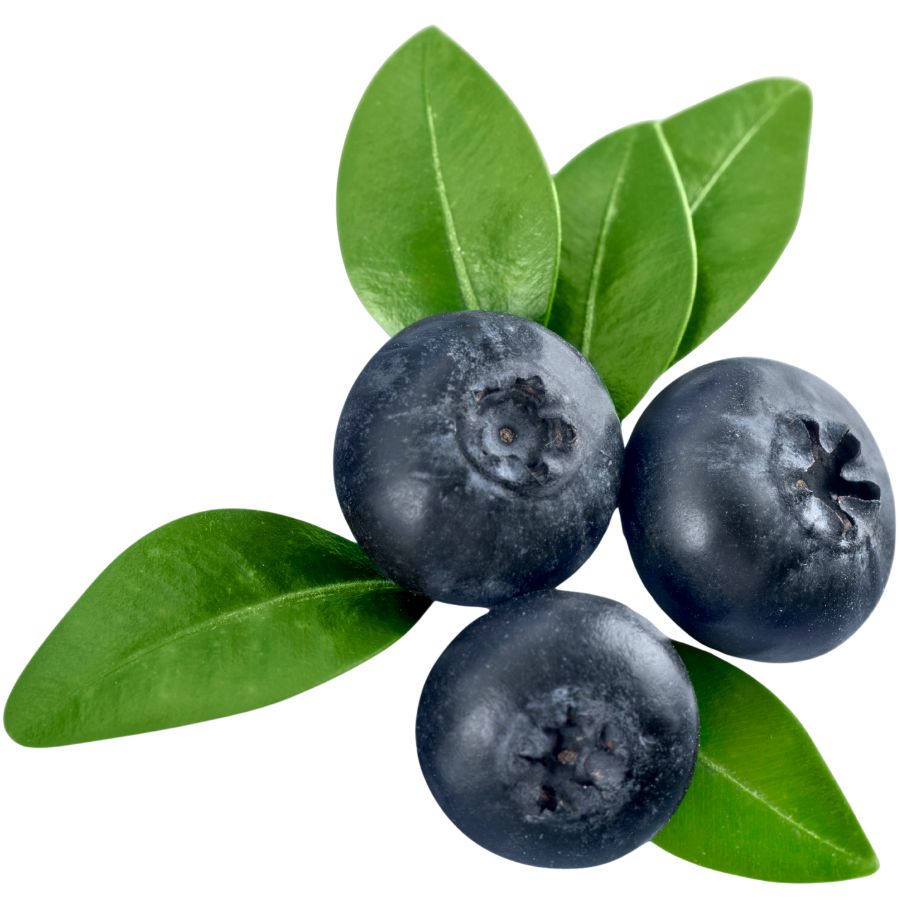
Blueberry, sometimes called highbush or lowbush blueberry depending on the type, grows as a shrub with smooth-edged, oval leaves and clusters of small white or pinkish bell-shaped flowers. The berries start green and ripen to a deep blue with a dusty-looking skin that easily rubs off.
A few lookalikes can confuse foragers, like the berries of Virginia creeper or pokeweed, but the differences are clear when you know what to check. True blueberries grow on woody shrubs and have a five-pointed crown on the bottom of each berry, while dangerous lookalikes often grow on vines or have no crown at all.
Blueberries have a sweet, sometimes tangy flavor and a juicy texture that makes them great for fresh eating. You can also bake them into pies, simmer them into jams, or dry them for snacks.
Only the ripe berries are eaten, while the leaves and stems are usually left alone.
Interestingly, blueberries is that they contain natural pigments that can turn recipes and even your fingers a deep purple when handled.
Orange Jewelweed (Impatiens capensis)
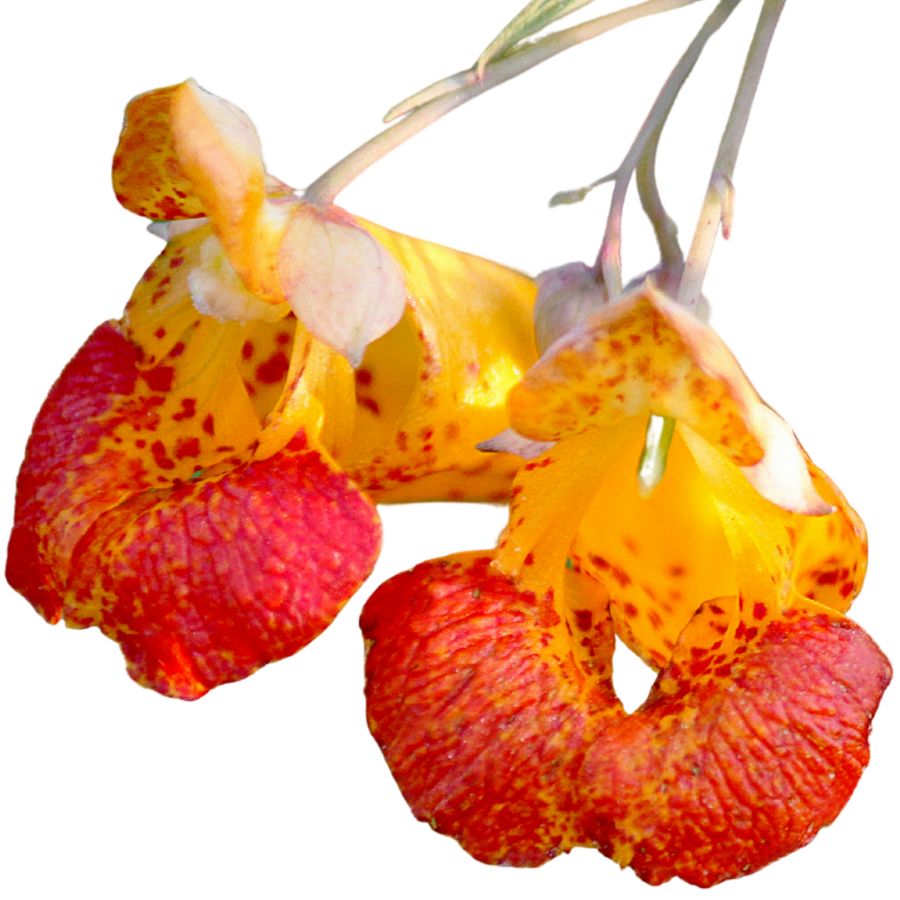
Orange jewelweed, sometimes called spotted touch-me-not or orange balsam, grows tall with juicy stems and bright orange, freckled flowers. The leaves are oval with fine teeth and often look silvery when wet, making them stand out in shady areas.
The tender young shoots are the part you want to use, but they have to be cooked thoroughly to be safe to eat. Boiling them in a few changes of water takes out the bitterness and neutralizes any compounds that can cause stomach upset.
When cooked properly, the shoots taste mild and slightly green, a bit like young spinach. They are often boiled and added to soups or stews, but you can also use them as a side dish after a final rinse with clean water.
Some people confuse orange jewelweed with garden balsam, which has similar-looking flowers but a rougher, more robust stem. Always check for the smooth, almost watery stem and the signature explosion of seeds when touched, which garden balsam does not have.
Burdock (Arctium minus)
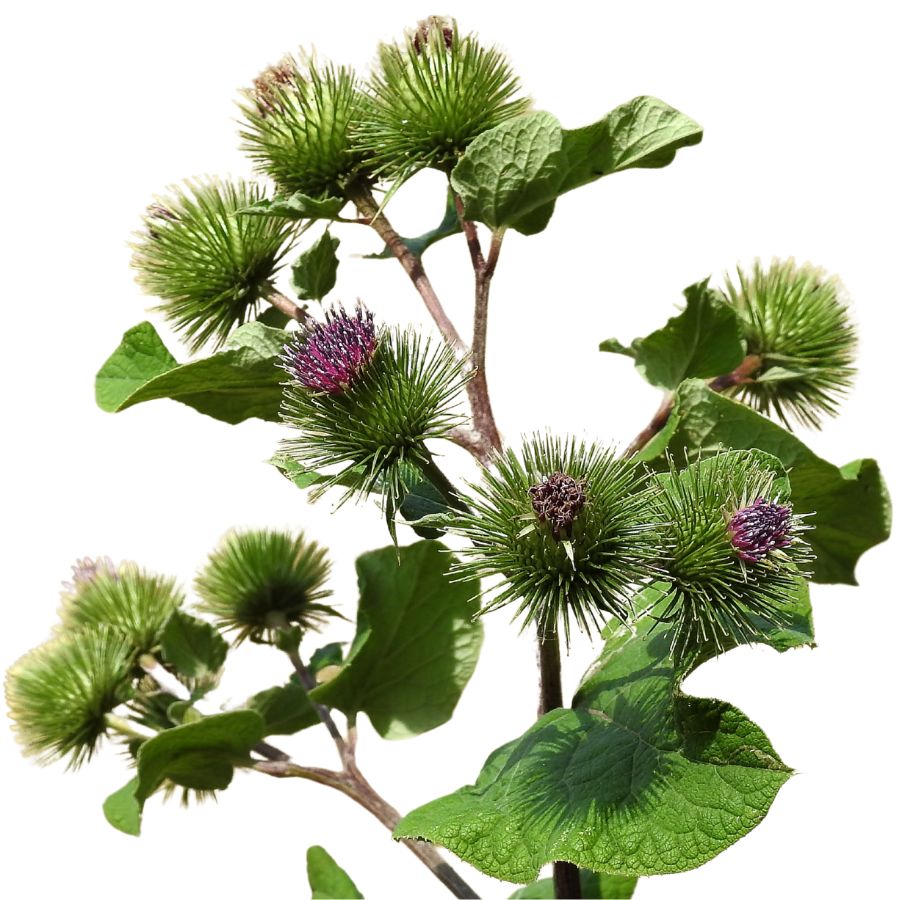
Burdock, also known as burrweed or beggar’s buttons, grows large, floppy leaves and produces clusters of sticky seed heads that cling to clothing and fur. The plant can easily tower over you once it matures, especially when the thick stalks shoot up.
The root is the main edible part and has a crisp texture with a mild, sweet, slightly earthy flavor when cooked. You should avoid eating the leaves or seed heads, as they tend to be unpleasantly bitter and tough even when young.
When you cook burdock root, it works well sliced thin and stir-fried, boiled into soups, or simmered with other vegetables to soak up savory flavors. Peeling the root before cooking can help soften the flavor and improve the texture.
It is important to watch out for lookalikes like foxglove and woolly mullein, which can grow similarly large leaves at the base. True burdock leaves have a whitish, fuzzy underside and strong, fibrous stems that are solid rather than hollow.
Milkweed (Asclepias syriaca)
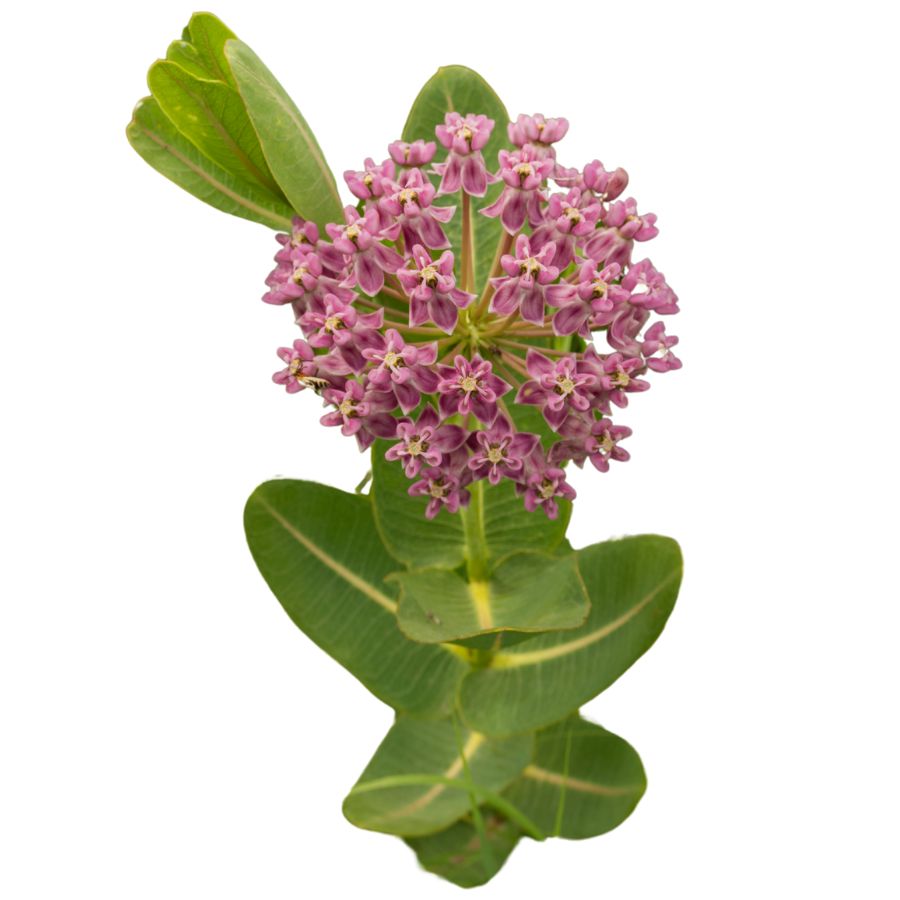
Known for its thick stems, broad leaves, and clusters of pinkish-purple flowers, common milkweed is sometimes called silkweed or butterfly flower. When you snap a stem or leaf, it releases a milky sap that helps you tell it apart from other plants that can be harmful.
If you want to try it in the kitchen, focus on gathering the young shoots, the tightly closed flower buds, and the small, immature pods. These parts have a mild, slightly sweet flavor when cooked, and their soft texture makes them a good addition to soups, sautés, and fritters.
Getting it ready to eat takes a little care, since boiling the plant parts in several changes of water helps remove bitterness and unwanted compounds. Some people also like to steam the buds or fry the pods lightly to bring out their best taste.
Although monarch caterpillars rely on this plant for survival, it has a long history of being used by people as well. Watch out for lookalikes like dogbane, though, since they share the same milky sap but are dangerously toxic if eaten.
Curly Dock (Rumex crispus)
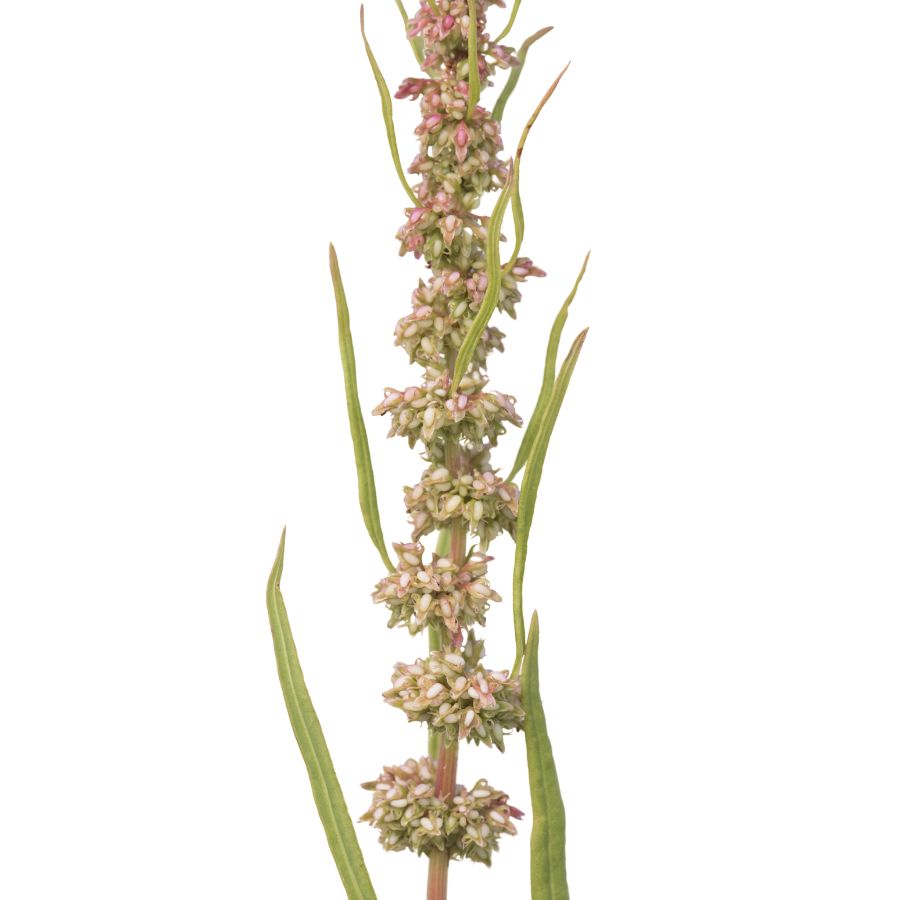
Curly dock, sometimes called yellow dock, is easy to spot once you know what to look for. It has long, wavy-edged leaves that form a rosette at the base, with tall stalks that eventually turn rusty brown as seeds mature.
The young leaves are edible and often cooked to mellow out their sharp, lemony taste, which can be too strong when eaten raw. You can also dry and powder the seeds to use as a flour supplement, although they are tiny and take some effort to prepare.
Curly dock has some lookalikes, like other types of dock and sorrel, but its heavily crinkled leaf edges and thick taproot help it stand out. Be careful not to confuse it with plants like wild rhubarb, which can have toxic parts if misidentified.
Besides being edible, curly dock has a history of being used in homemade remedies for skin irritation. The roots are not eaten raw because they are tough and contain compounds that can upset your stomach if you are not careful.
Common Blue Violet (Viola sororia)
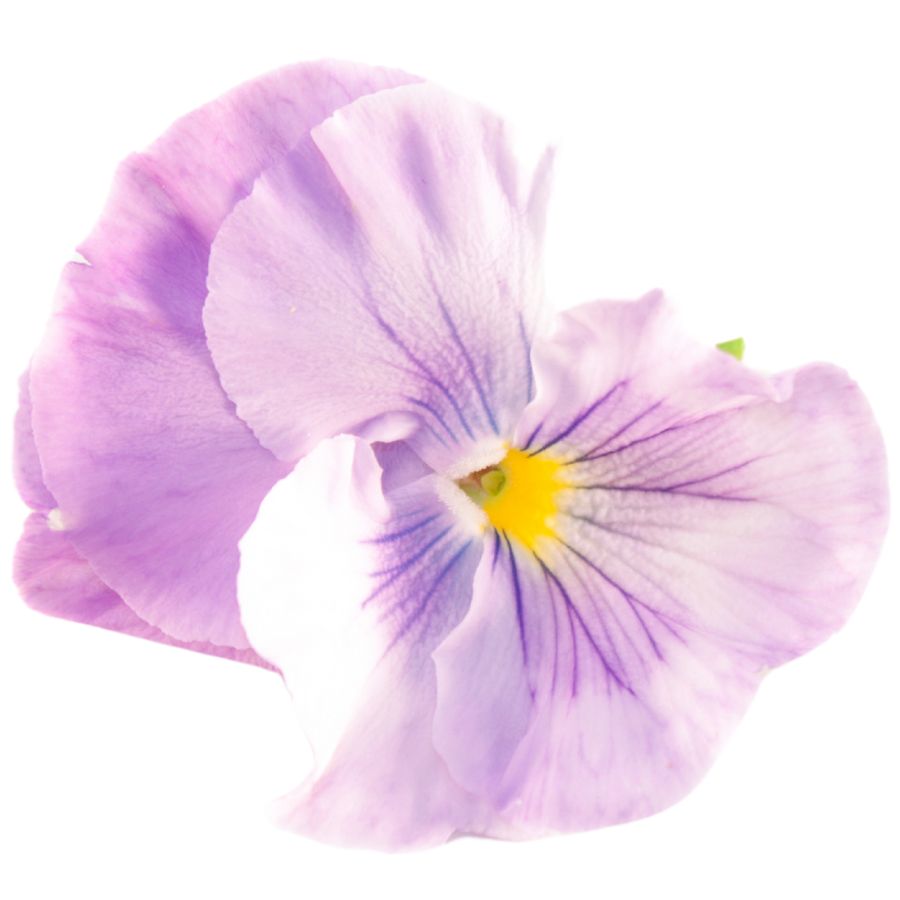
Common blue violet, also called wood violet and meadow violet, grows close to the ground with heart-shaped leaves and purple flowers. The blossoms have five petals, with the lower petal often streaked in darker lines that act like nectar guides for pollinators.
You can eat both the flowers and the young leaves, but skip the older leaves since they tend to get tough and stringy. The blooms taste mild and a little sweet, while the leaves are more grassy and bland.
People often use the flowers to decorate cakes, candy them for treats, or toss them into salads for a pop of color. The leaves can be thrown into soups or smoothies, but it is better to chop them fine because they have a slightly mucilaginous texture.
One plant that sometimes gets confused with common blue violet is lesser celandine, which has shiny, darker leaves and starry yellow flowers instead of purple ones. Always double-check before gathering because eating lesser celandine raw can make you sick.
Daylily (Hemerocallis fulva)

Bright orange flowers known as daylily, tiger lily, or ditch lily can sometimes be mistaken for other plants that are not safe to eat. True daylilies have long, blade-like leaves that grow in clumps at the base and a hollow flower stem, while their toxic lookalikes often have solid stems or different leaf patterns.
When it comes to flavor, daylily buds have a crisp texture and a mild taste that some people compare to green beans or asparagus. The flowers are tender and slightly sweet, which makes them popular for tossing into salads or lightly stir-frying.
Most people use the unopened flower buds in cooking, but the young shoots and tuber-like roots are also gathered for food. Always make sure you are harvesting from clean areas, because roadside plants can carry pollutants that are not safe to eat.
A few important cautions come with daylilies, since some people experience digestive upset after eating large amounts. Start by tasting a small quantity first to see how your body reacts before eating more.
Chickweed (Stellaria media)
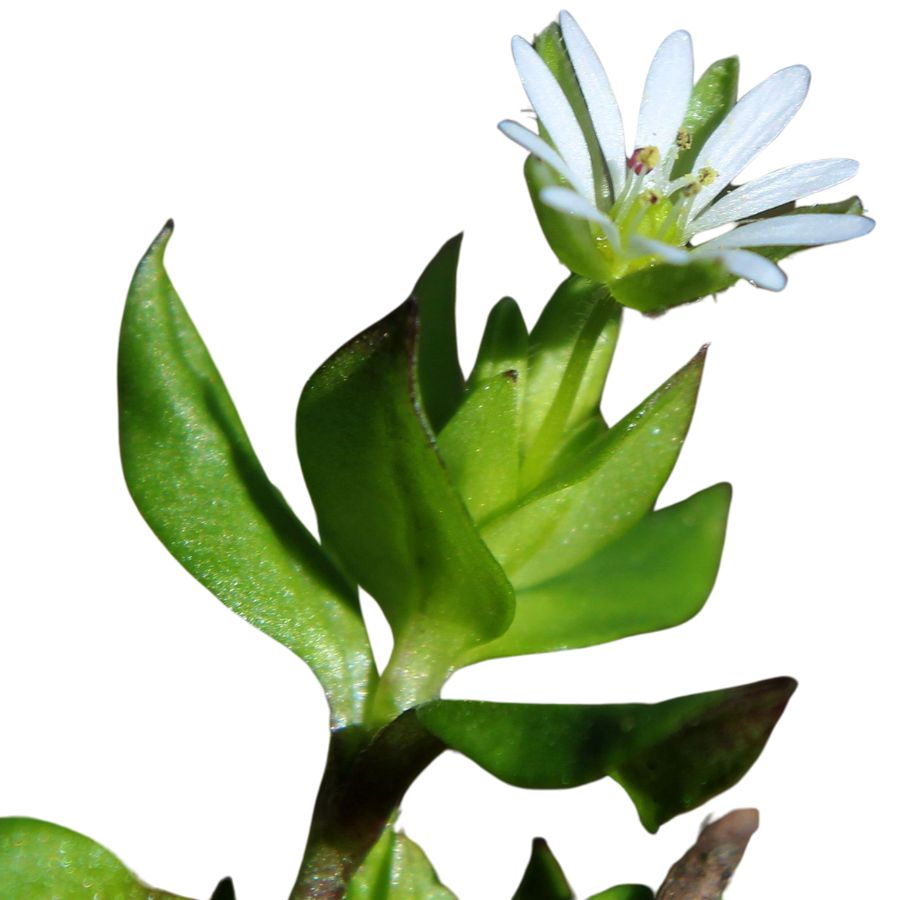
Chickweed, sometimes called satin flower or starweed, is a small, low-growing plant with delicate white star-shaped flowers and bright green leaves. The leaves are oval, pointed at the tip, and often grow in pairs along a slender, somewhat weak-looking stem.
When gathering chickweed, watch out for lookalikes like scarlet pimpernel, which has similar leaves but orange flowers instead of white. A key detail to check is the fine line of hairs that runs along one side of chickweed’s stem, a feature the dangerous lookalikes do not have.
The young leaves, tender stems, and flowers of chickweed are all edible, offering a mild, slightly grassy flavor with a crisp texture. You can toss it fresh into salads, blend it into pestos, or lightly wilt it into soups and stir-fries for a fresh green boost.
Aside from being a food plant, chickweed has been used traditionally in poultices and salves to help soothe skin irritations. Always make sure the plant is positively identified before eating, since mistaking it for a toxic lookalike could cause serious issues.
Black Raspberry (Rubus occidentalis)
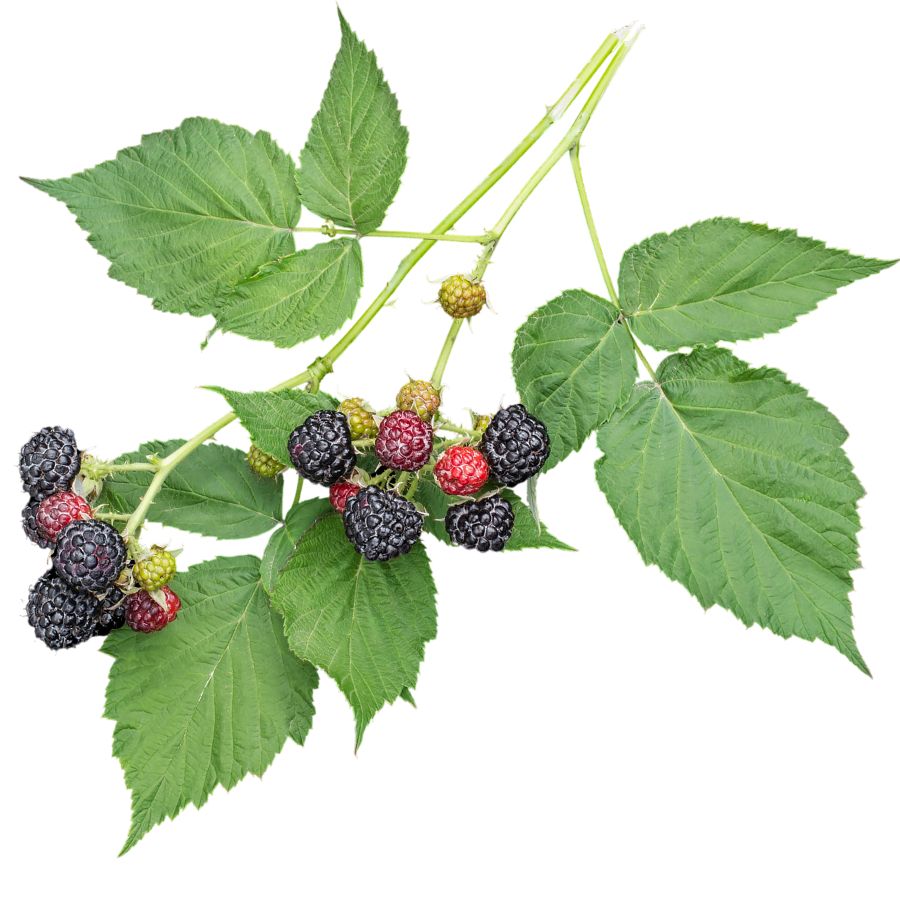
Black raspberries grow on arching canes covered with small, hooked thorns. The berries start out red before ripening to a deep purplish-black color, and they have a hollow core when picked.
The fruit tastes sweet with a mild tartness, and the texture is juicy but slightly firmer than a red raspberry. People often use black raspberries for jams, pies, syrups, and even simple fruit leathers made at home.
Blackberry and wineberry are common lookalikes, which can confuse foragers at first glance. Black raspberry canes usually have a whitish coating and smaller thorns compared to the shinier, stouter canes of a blackberry.
You can eat the ripe fruit raw or cooked, but the leaves are sometimes brewed into teas after proper drying. It is best to avoid the green, unripe berries, as they are tough and lack the flavor that makes black raspberry such a favorite.
Elderberry (Sambucus nigra subsp. canadensis)
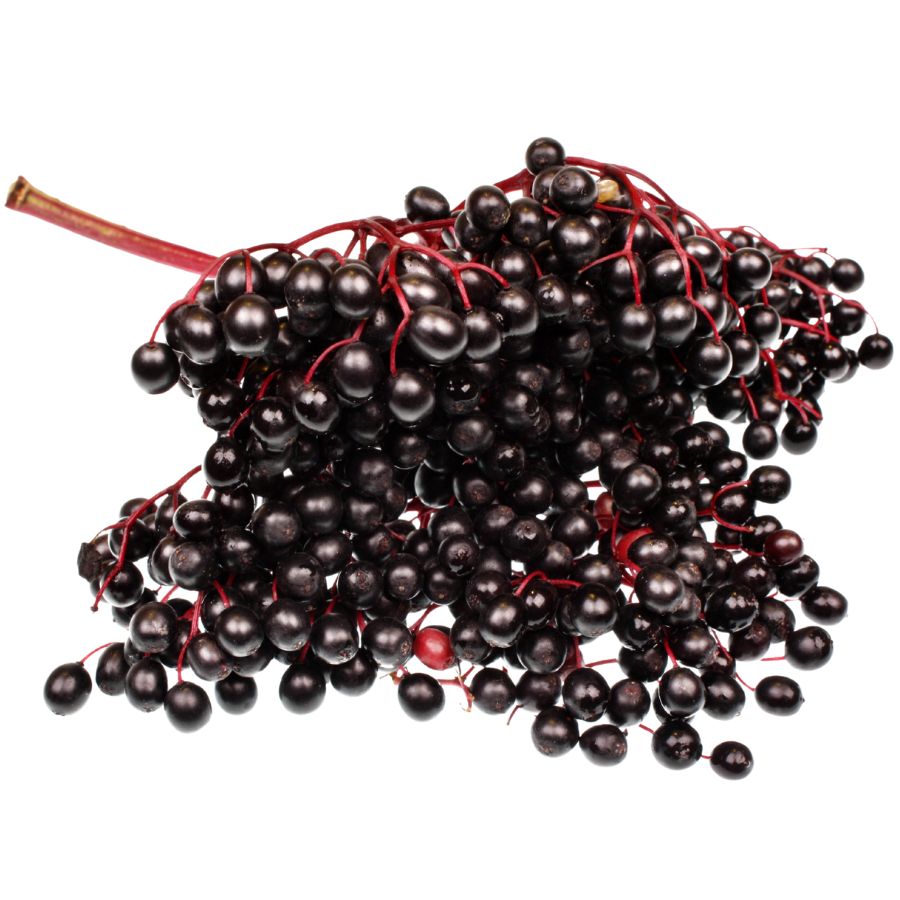
Elderberry is often called American elder, common elder, or sweet elder. It grows as a large, shrubby plant with clusters of tiny white flowers that eventually turn into deep purple to black berries.
You can recognize elderberry by its compound leaves with five to eleven serrated leaflets and its flat-topped flower clusters. One important thing to watch out for is its toxic lookalikes, like pokeweed, which has very different smooth-edged leaves and reddish stems.
The ripe berries have a tart, almost earthy flavor and a soft texture when cooked. People usually cook elderberries into syrups, jams, pies, or wine because eating raw berries can cause nausea.
Only the ripe, cooked berries and flowers are edible, while the leaves, stems, and unripe berries are toxic. Always take care to strip the berries cleanly from their stems before using them, as even small bits of stem can cause problems.
Serviceberry (Amelanchier canadensis, Amelanchier arborea)
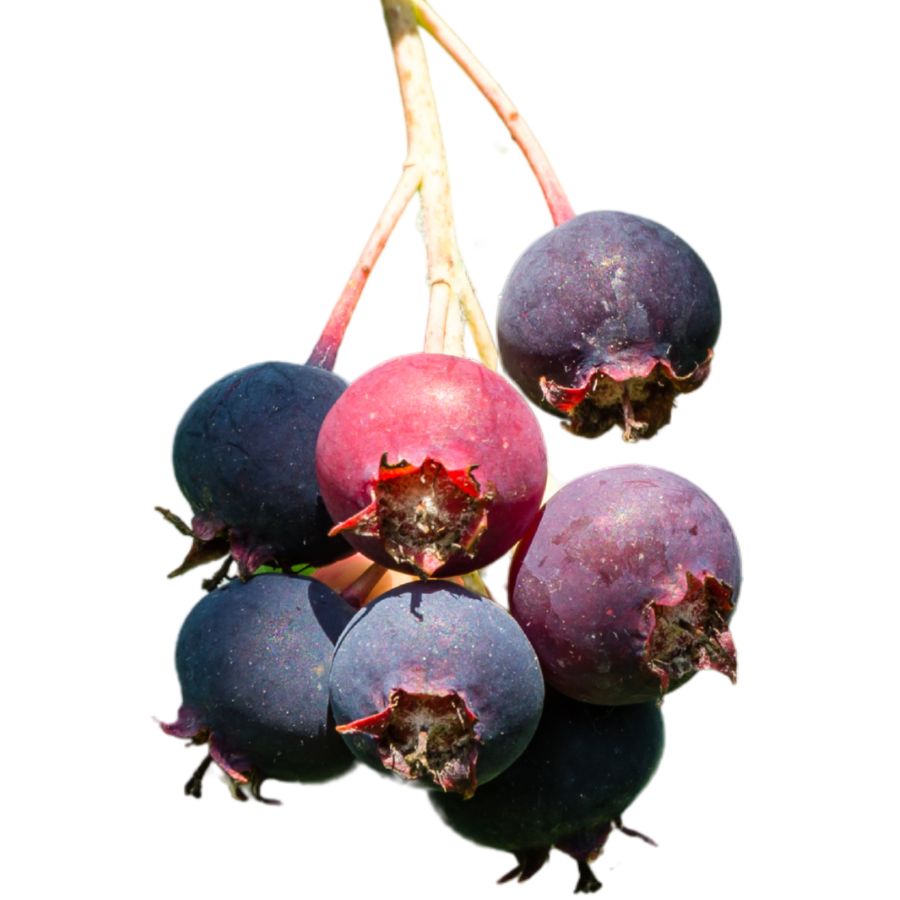
Sweet and often compared to blueberries, serviceberry fruit grows in clusters on small trees and shrubs known by names like juneberry, shadbush, and sarvisberry. When ripe, the berries are deep purple to almost black, and they have a soft, juicy texture that bursts with flavor when you bite into them.
You can tell serviceberries apart from similar-looking plants like chokecherries by paying close attention to the leaves and the berry structure. Serviceberry leaves are finely toothed and oval, while chokecherry leaves tend to be more heavily serrated and broader near the tip.
The fruit has a mild, slightly nutty flavor underneath its berry sweetness, making it perfect for pies, jams, and even simple snacking straight off the tree. Some people like to dry the berries for later use, grinding them into meal or adding them to baked goods.
Only the berries are good for eating, so avoid trying other parts of the plant like the bark or leaves. Interestingly, serviceberry seeds have a faint almond taste, a reminder that this plant is part of the rose family just like apples and cherries.
Dandelion (Taraxacum officinale)
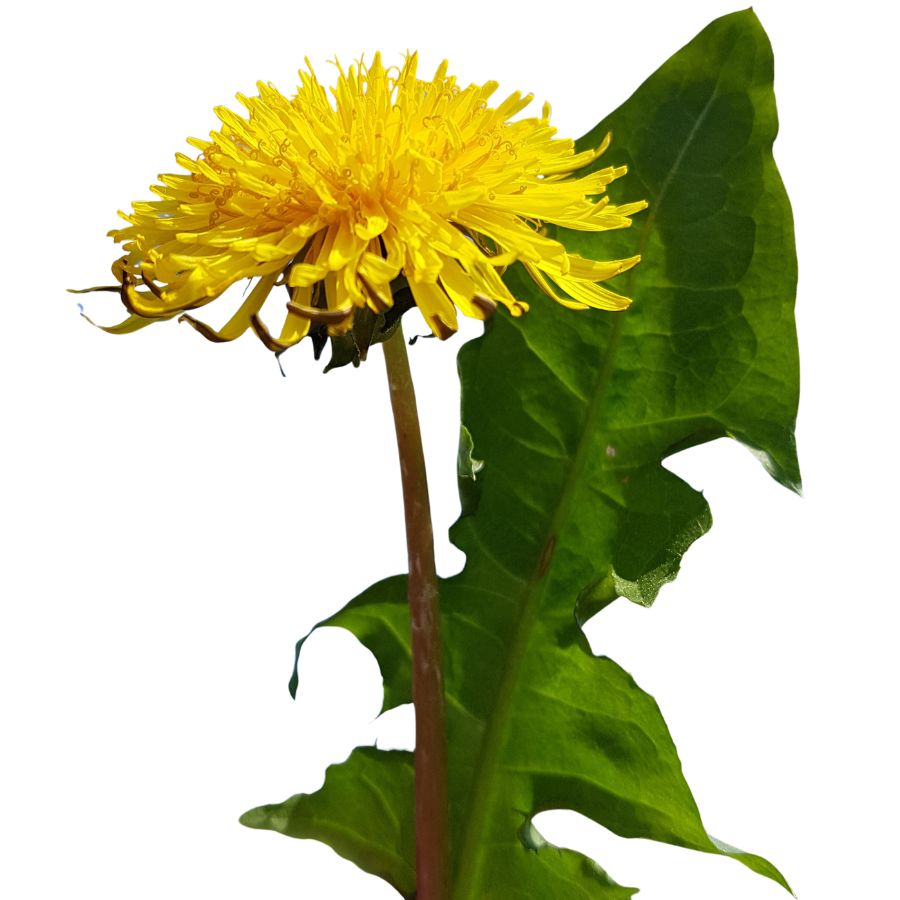
Bright yellow flowers and jagged, deeply toothed leaves make dandelions easy to spot in open fields, lawns, and roadsides. You might also hear them called lion’s tooth, blowball, or puffball once the flowers turn into round, white seed heads.
Every part of the dandelion is edible, but you will want to avoid harvesting from places treated with pesticides or roadside areas with heavy car traffic. Besides being a food source, dandelions have been used traditionally for simple herbal remedies and natural dye projects.
Young dandelion leaves have a slightly bitter, peppery flavor that works well in salads or sautés, and the flowers can be fried into fritters or brewed into tea. Some people even roast the roots to make a coffee substitute with a rich, earthy taste.
One thing to watch out for is cat’s ear, a common lookalike with hairy leaves and branching flower stems instead of a single, hollow one. To make sure you have a true dandelion, check for a smooth, hairless stem that oozes a milky sap when broken.
Cattail (Typha latifolia, Typha angustifolia)
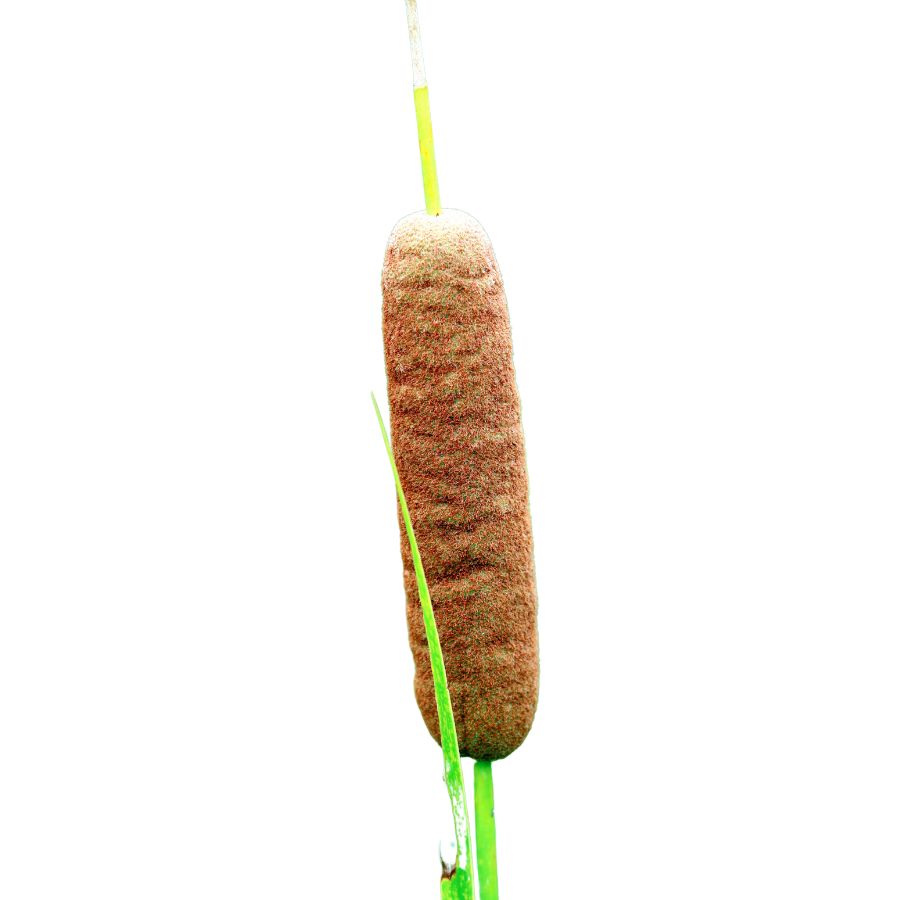
Cattails, often called bulrushes or corn dog grass, are easy to spot with their tall green stalks and brown, sausage-shaped flower heads. They grow thickly along the edges of ponds, lakes, and marshes, forming dense stands that are hard to miss.
Almost every part of the cattail is edible, including the young shoots, flower heads, and starchy rhizomes. You can eat the tender shoots raw, boil the flower heads like corn on the cob, or grind the rhizomes into flour for baking.
Besides food, cattails have long been used for making mats, baskets, and even insulation by weaving the dried leaves and using the fluffy seeds. Their combination of usefulness and abundance has made them an important survival plant for many cultures.
One thing you need to watch for is young cattail shoots being confused with similar-looking plants like iris, which are toxic. A real cattail shoot will have a mild cucumber-like smell when you snap it open, while iris plants smell bitter or unpleasant.
Mulberry (Morus alba, Morus rubra)
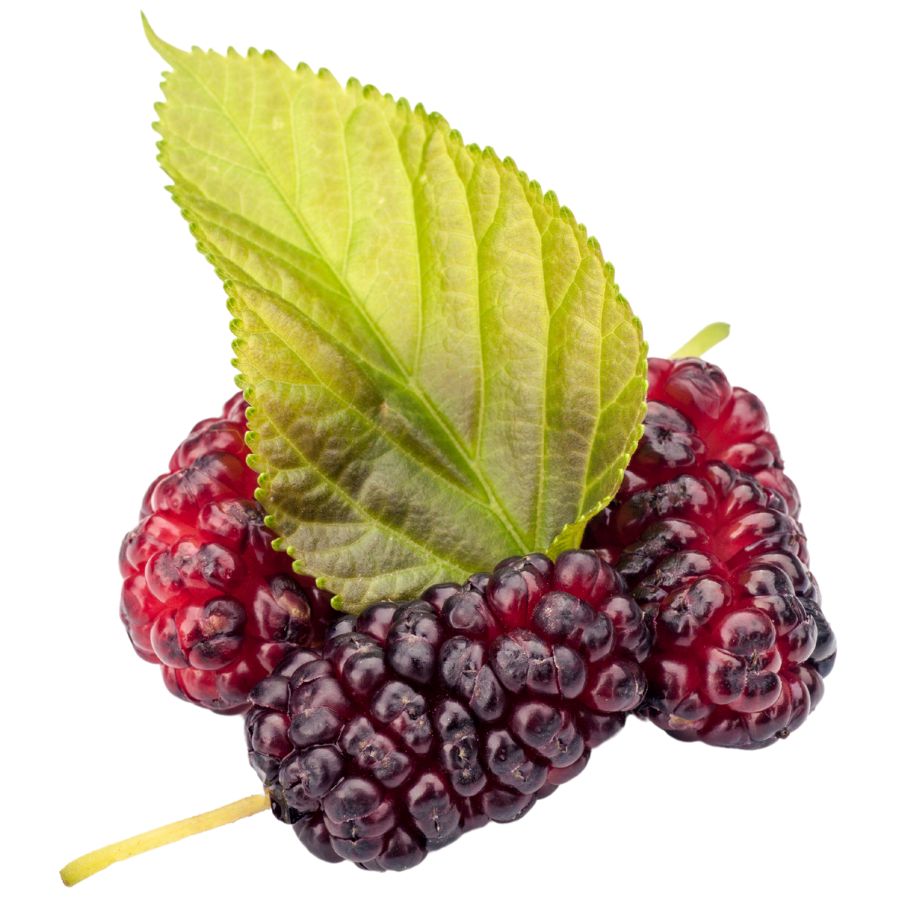
American beautyberry, sometimes called French mulberry or sourbush, is highly easily recognizable thanks to its bright clusters of purple berries wrapped tightly around its stems. The plant itself has arching branches and broad, serrated leaves that give off a slight spicy scent when crushed.
The berries are edible and have a mild, slightly sweet flavor with a soft, juicy texture that some people find a little gritty. Only the ripe purple berries should be eaten, as the leaves and unripe berries are not considered edible.
One of the easiest ways to enjoy beautyberries is by making jelly, where the fruit’s subtle taste really shines through. Some people also simmer the berries into syrups or add them to baked goods, although the flavor can be too delicate to stand out without a little help from sugar or lemon.
Beautyberries are sometimes confused with pokeweed, but pokeweed’s berries are a darker purple and grow on red stems in drooping clusters rather than tight whorls. Always double-check the plant’s structure and berry arrangement so you can be sure you are harvesting true American beautyberry.
Wild Strawberry (Fragaria virginiana)
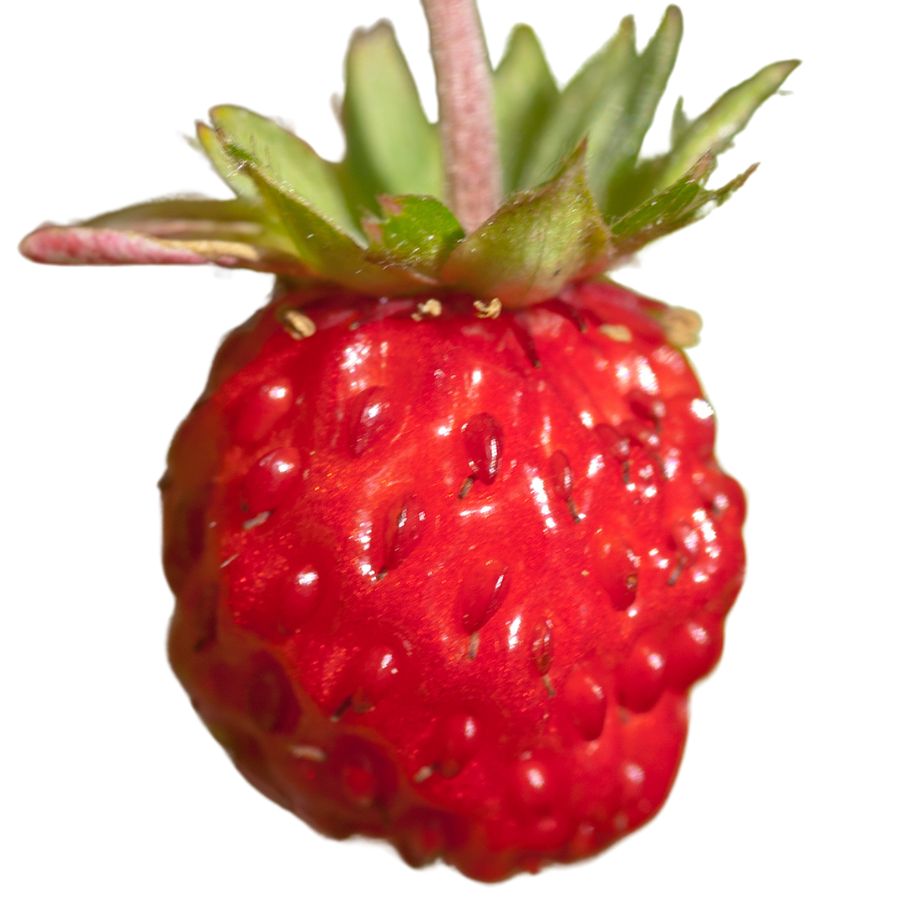
Wild strawberry, sometimes called Virginia strawberry or mountain strawberry, grows low to the ground with three-part leaves that have jagged edges. The small white flowers with yellow centers eventually give way to tiny, bright red fruits nestled close to the soil.
The fruits are sweet with a burst of tartness, and their texture is much softer than the large cultivated strawberries you find in stores. You can eat them raw, mix them into jams, or bake them into pies for a rich, fruity flavor.
Wild strawberry can sometimes be confused with mock strawberry, which has similar leaves but produces dry, flavorless fruits and yellow flowers instead of white. Always check the flower color and taste a small piece before collecting more.
Only the berries and the tender young leaves of wild strawberry are edible, with the leaves often brewed into teas. Be careful not to overharvest because these plants grow slowly and support plenty of small wildlife.
Wild Leek / Ramp (Allium tricoccum)
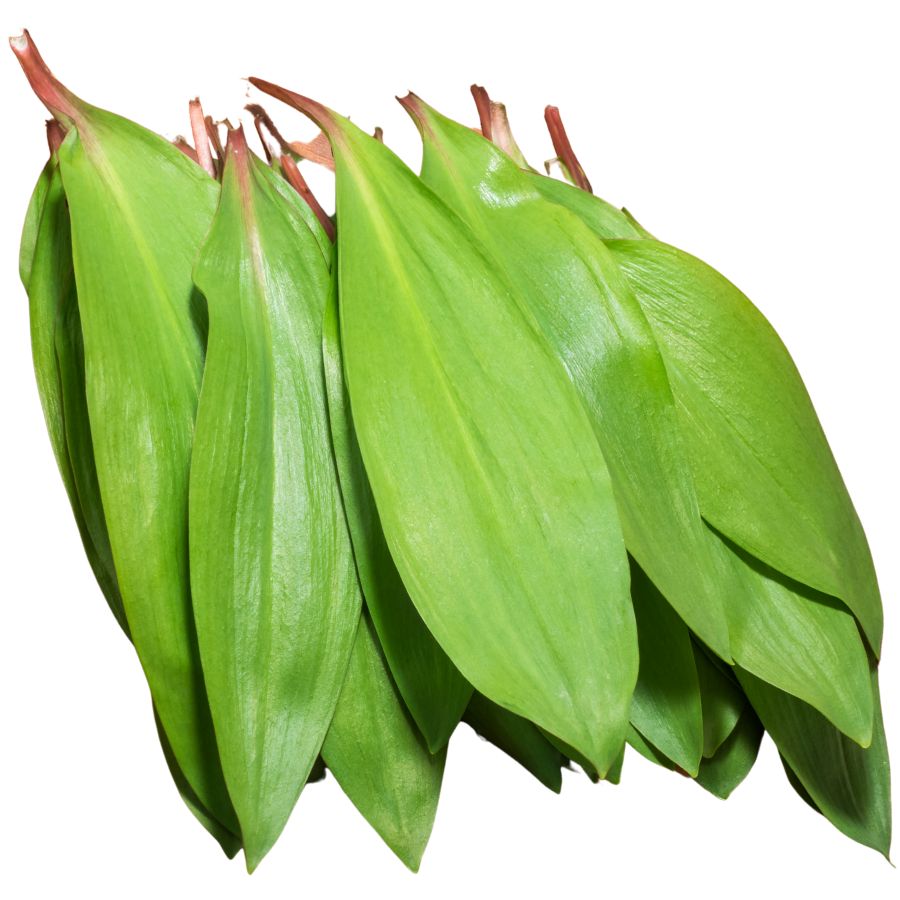
Known as wild leek, ramp, or ramson, this flavorful plant is famous for its broad green leaves and slender white stems. It grows low to the ground and gives off a strong onion-like scent when bruised, which can help you tell it apart from toxic lookalikes like lily of the valley.
If you give it a taste, you will notice a bold mix of onion and garlic flavors, with a tender texture that softens even more when cooked. People often sauté the leaves and stems, pickle the bulbs, or blend them into pestos and soups.
The entire plant can be used for cooking, but the leaves and bulbs are the most prized parts. It is important not to confuse it with similar-looking plants that do not have the signature onion smell when crushed.
Wild leek populations have declined in some areas because of overharvesting, so it is a good idea to only take a few from any given patch. When harvested thoughtfully, these vibrant greens can add a punch of flavor to just about anything you make.
Garlic Mustard (Alliaria petiolata)
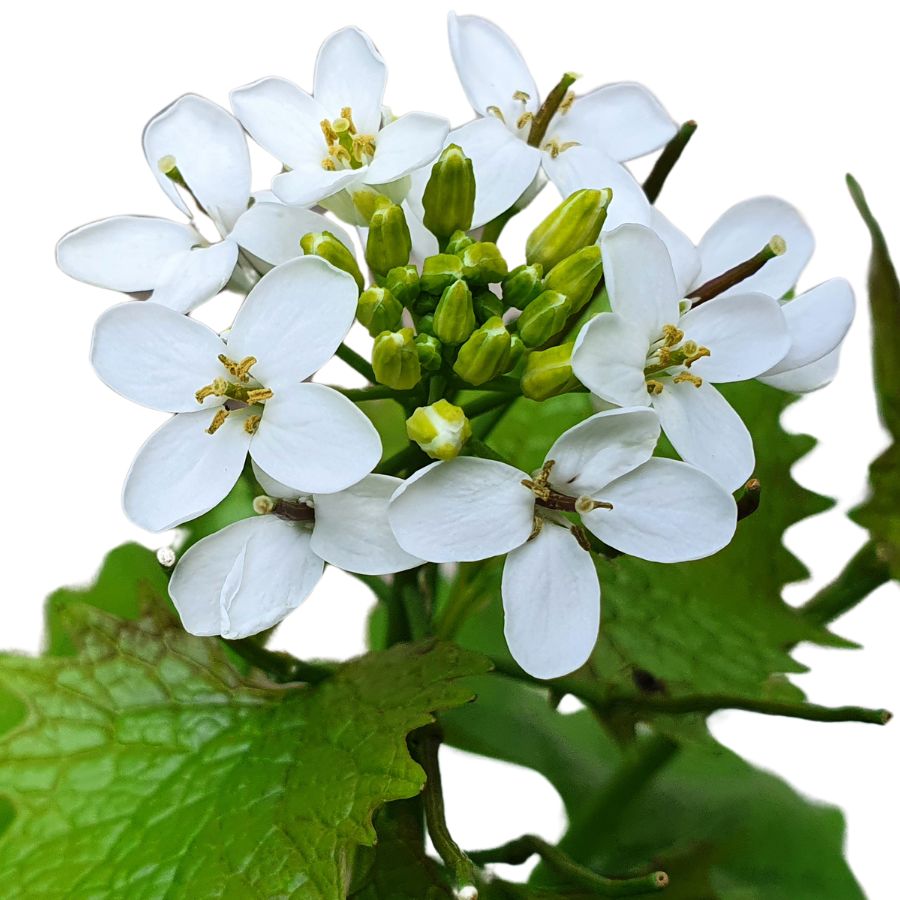
Garlic mustard, sometimes called poor man’s mustard or hedge garlic, has heart-shaped leaves with scalloped edges and small white four-petaled flowers. When you crush the leaves between your fingers, they release a strong garlic-like smell that makes it stand out from similar-looking plants.
The flavor of garlic mustard is sharp and garlicky at first bite, with a peppery bitterness that lingers. Its young leaves are often blended into pestos, stirred into soups, or tossed into salads to add a punch of flavor.
You can also use the roots, which have a taste similar to horseradish when fresh. The seed pods are sometimes collected and used as a spicy seasoning after being dried and crushed.
If you decide to gather some, make sure not to confuse it with plants like ground ivy or purple deadnettle, which do not have that garlic aroma. Stick to harvesting the leaves, flowers, seeds, and roots, and avoid anything with a fuzzy texture or a very different smell.
Toxic Plants That Look Like Edible Plants
There are plenty of wild edibles to choose from, but some toxic native plants closely resemble them. Mistaking the wrong one can lead to severe illness or even death, so it’s important to know exactly what you’re picking.
Poison Hemlock (Conium maculatum)
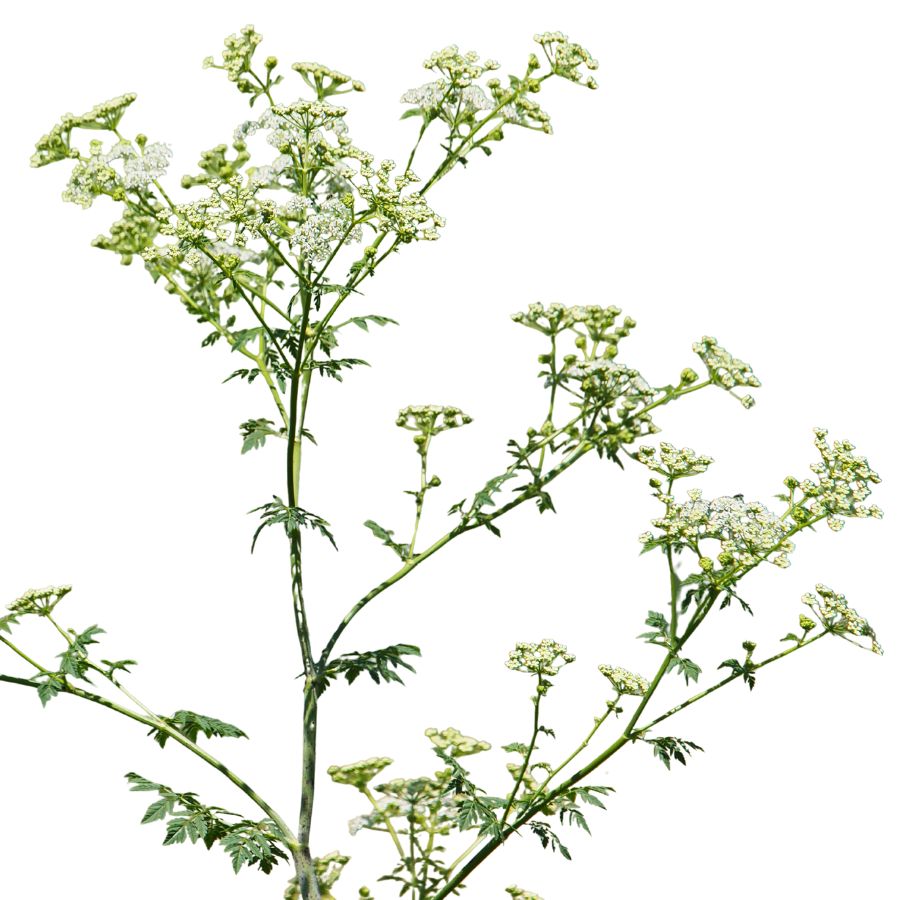
Often mistaken for: Wild carrot (Daucus carota)
Poison hemlock is a tall plant with lacy leaves and umbrella-like clusters of tiny white flowers. It has smooth, hollow stems with purple blotches and grows in sunny places like roadsides, meadows, and stream banks.
Unlike wild carrot, which has hairy stems and a dark central floret, poison hemlock has a musty odor and no flower center spot. It’s extremely toxic; just a small amount can be fatal, and even touching the sap can irritate the skin.
Water Hemlock (Cicuta spp.)
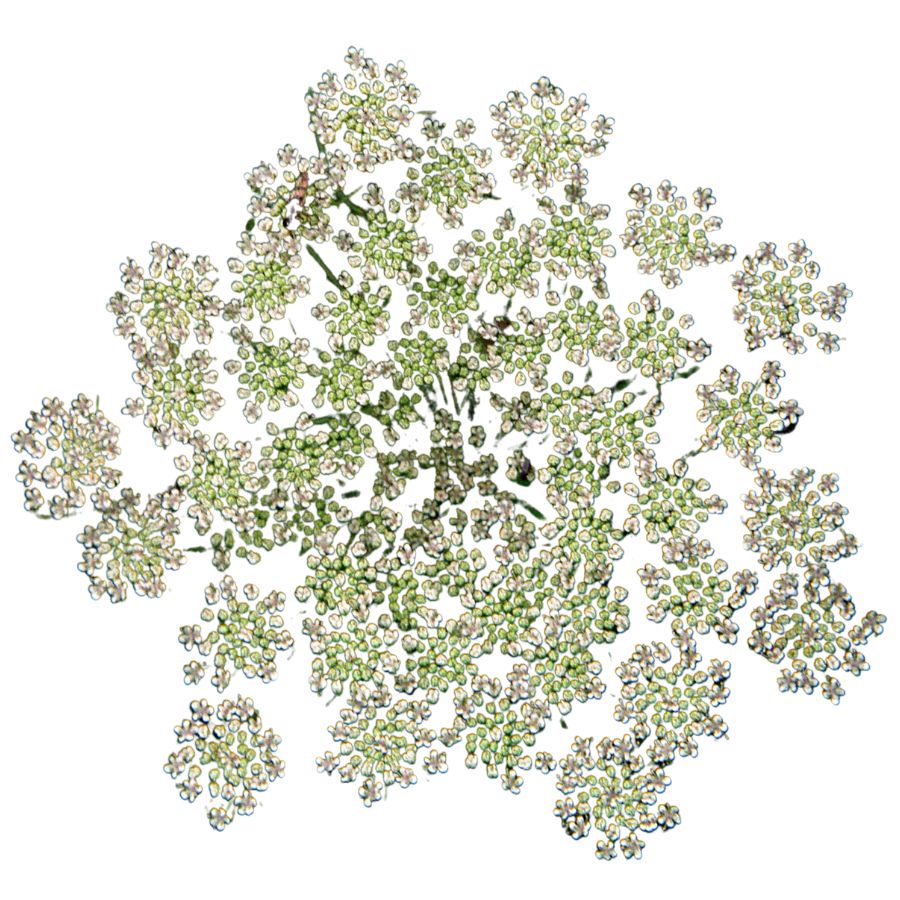
Often mistaken for: Wild parsnip (Pastinaca sativa) or wild celery (Apium spp.)
Water hemlock is a tall, branching plant with umbrella-shaped clusters of small white flowers. It grows in wet places like stream banks, marshes, and ditches, with stems that often show purple streaks or spots.
It can be confused with wild parsnip or wild celery, but its thick, hollow roots have internal chambers and release a yellow, foul-smelling sap when cut. Water hemlock is the most toxic plant in North America, and just a small amount can cause seizures, respiratory failure, and death.
False Hellebore (Veratrum viride)
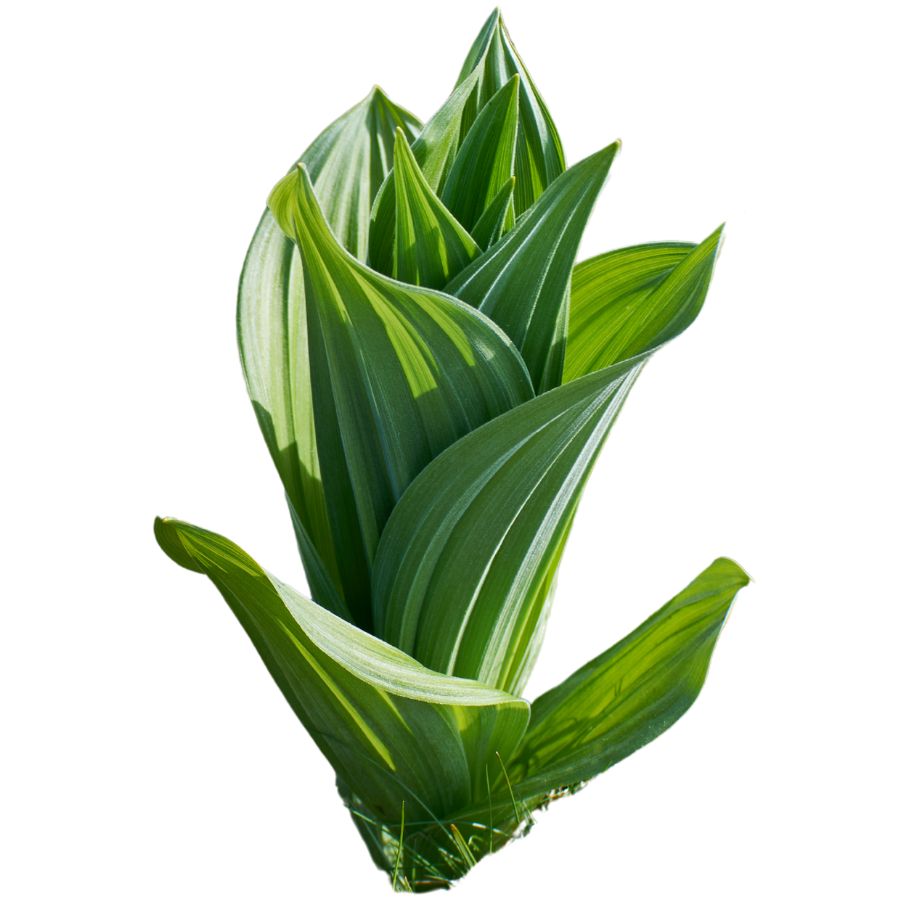
Often mistaken for: Ramps (Allium tricoccum)
False hellebore is a tall plant with broad, pleated green leaves that grow in a spiral from the base, often appearing early in spring. It grows in moist woods, meadows, and along streams.
It’s commonly mistaken for ramps, but ramps have a strong onion or garlic smell, while false hellebore is odorless and later grows a tall flower stalk. The plant is highly toxic, and eating any part can cause nausea, a slowed heart rate, and even death due to its alkaloids that affect the nervous and cardiovascular systems.
Death Camas (Zigadenus spp.)
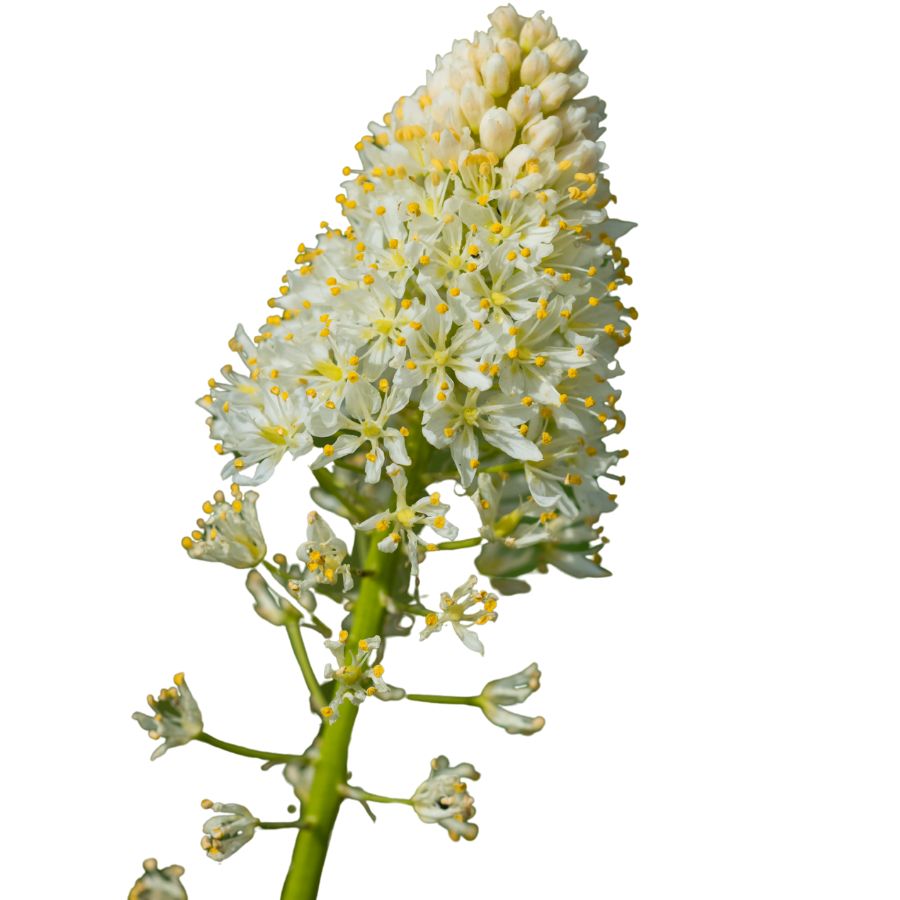
Often mistaken for: Wild onion or wild garlic (Allium spp.)
Death camas is a slender, grass-like plant that grows from underground bulbs and is found in open woods, meadows, and grassy hillsides. It has small, cream-colored flowers in loose clusters atop a tall stalk.
It’s often confused with wild onion or wild garlic due to their similar narrow leaves and habitats, but only Allium plants have a strong onion or garlic scent, while death camas has none. The plant is extremely poisonous, especially the bulbs, and even a small amount can cause nausea, vomiting, a slowed heartbeat, and potentially fatal respiratory failure.
Buckthorn Berries (Rhamnus spp.)
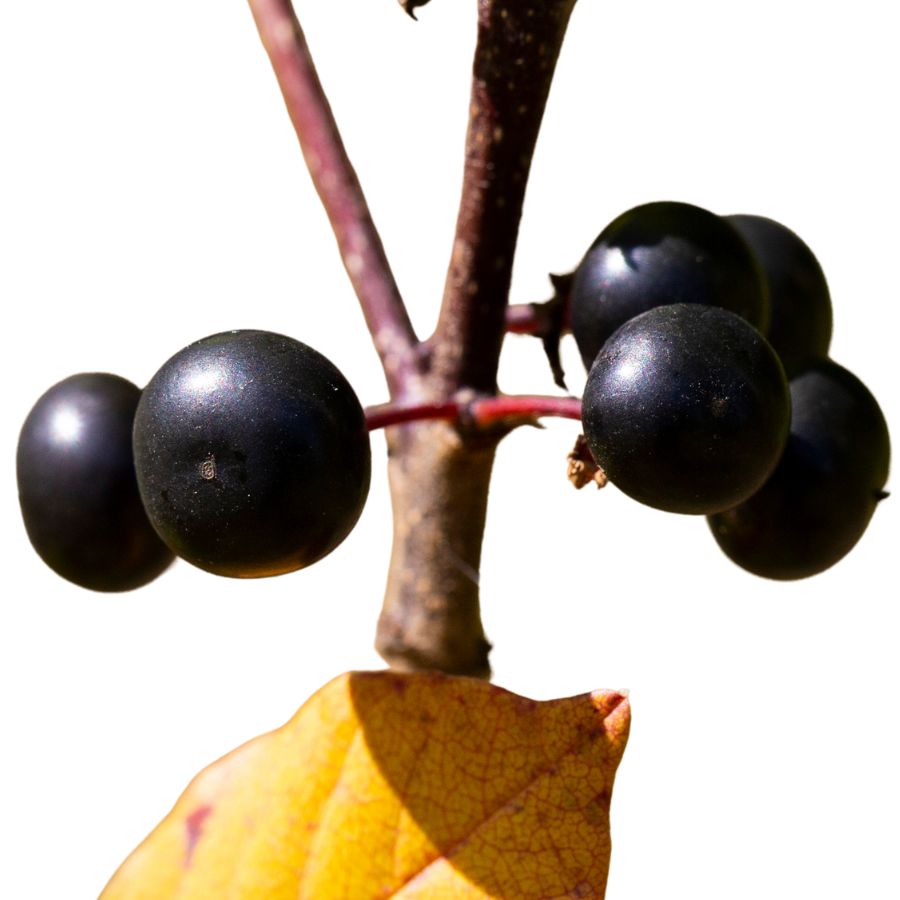
Often mistaken for: Elderberries (Sambucus spp.)
Buckthorn is a shrub or small tree often found along woodland edges, roadsides, and disturbed areas. It produces small, round berries that ripen to dark purple or black and usually grow in loose clusters.
These berries are sometimes mistaken for elderberries and other wild fruits, which also grow in dark clusters, but elderberries form flat-topped clusters on reddish stems while buckthorn berries are more scattered. Buckthorn berries are unsafe to eat as they contain compounds that can cause cramping, vomiting, and diarrhea, and large amounts may lead to dehydration and serious digestive problems.
Mayapple (Podophyllum peltatum)
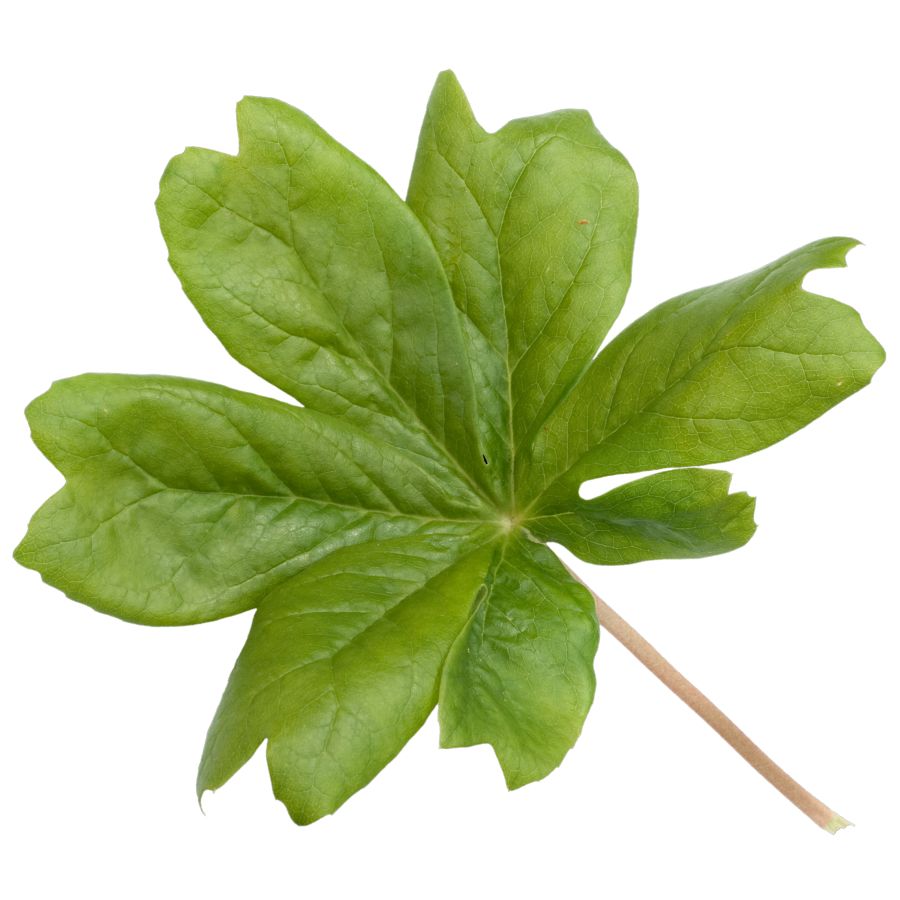
Often mistaken for: Wild grapes (Vitis spp.)
Mayapple is a low-growing plant found in shady forests and woodland clearings. It has large, umbrella-like leaves and produces a single pale fruit hidden beneath the foliage.
The unripe fruit resembles a small green grape, causing confusion with wild grapes, which grow in woody clusters on vines. All parts of the mayapple are toxic except the fully ripe, yellow fruit, which is only safe in small amounts. Eating unripe fruit or other parts can lead to nausea, vomiting, and severe dehydration.
Virginia Creeper (Parthenocissus quinquefolia)
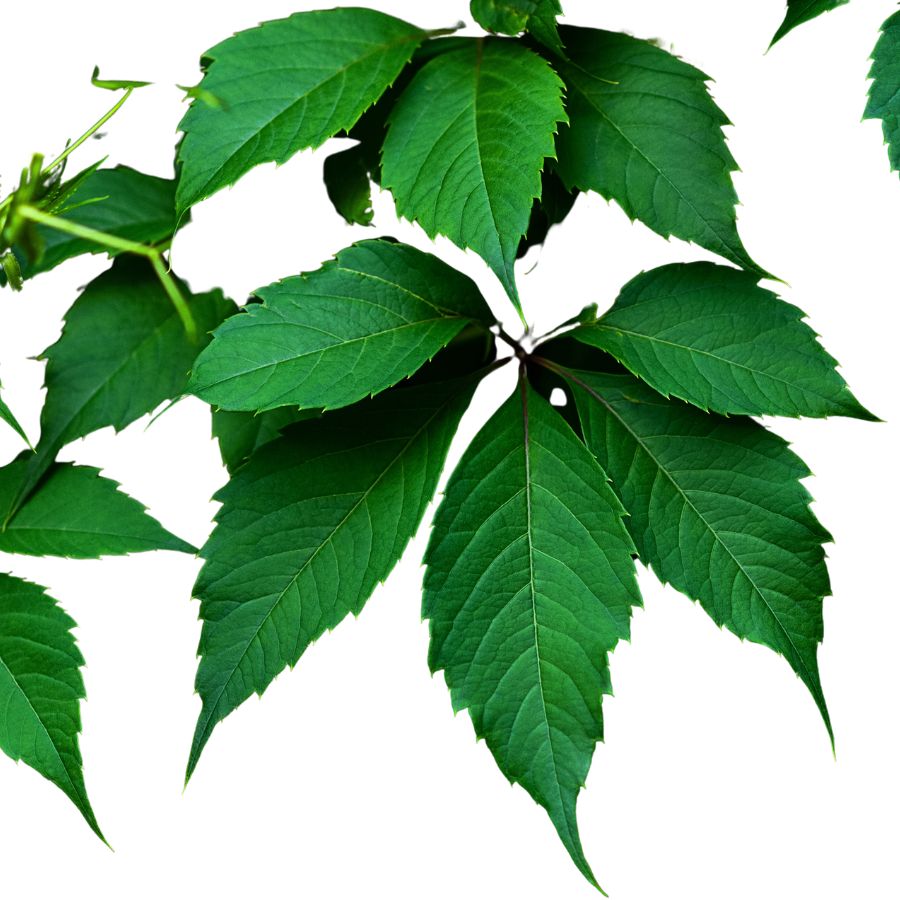
Often mistaken for: Wild grapes (Vitis spp.)
Virginia creeper is a fast-growing vine found on fences, trees, and forest edges. It has five leaflets per stem and produces small, bluish-purple berries from late summer to fall.
It’s often confused with wild grapes since both are climbing vines with similar berries, but grapevines have large, lobed single leaves and tighter fruit clusters. Virginia creeper’s berries are toxic to humans and contain oxalate crystals that can cause nausea, vomiting, and throat irritation.
Castor Bean (Ricinus communis)
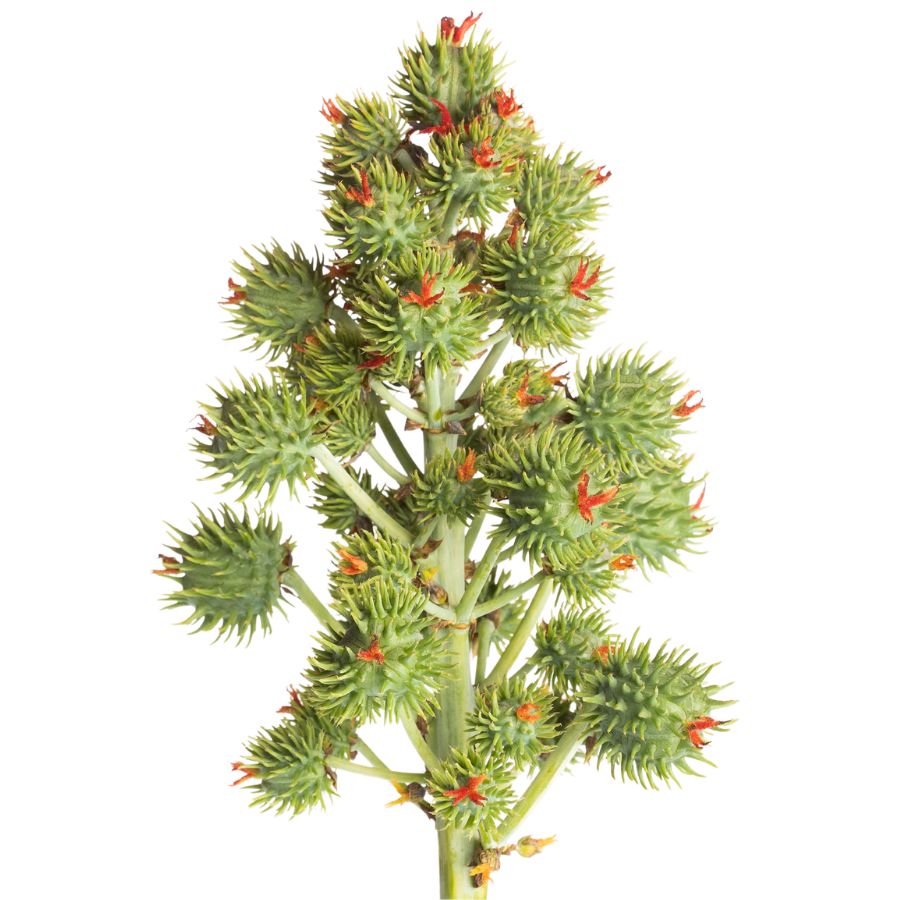
Often mistaken for: Wild rhubarb (Rumex spp. or Rheum spp.)
Castor bean is a bold plant with large, lobed leaves and tall red or green stalks, often found in gardens, along roadsides, and in disturbed areas in warmer regions in the US. Its red-tinged stems and overall size can resemble wild rhubarb to the untrained eye.
Unlike rhubarb, castor bean plants produce spiny seed pods containing glossy, mottled seeds that are extremely toxic. These seeds contain ricin, a deadly compound even in small amounts. While all parts of the plant are toxic, the seeds are especially dangerous and should never be handled or ingested.
Before you head out
Before embarking on any foraging activities, it is essential to understand and follow local laws and guidelines. Always confirm that you have permission to access any land and obtain permission from landowners if you are foraging on private property. Trespassing or foraging without permission is illegal and disrespectful.
For public lands, familiarize yourself with the foraging regulations, as some areas may restrict or prohibit the collection of mushrooms or other wild foods. These regulations and laws are frequently changing so always verify them before heading out to hunt. What we have listed below may be out of date and inaccurate as a result.
How to Get the Best Results Foraging
Safety should always come first when it comes to foraging. Whether you’re in a rural forest or a suburban greenbelt, knowing how to harvest wild foods properly is a key part of staying safe and respectful in the field.
Always Confirm Plant ID Before You Harvest Anything
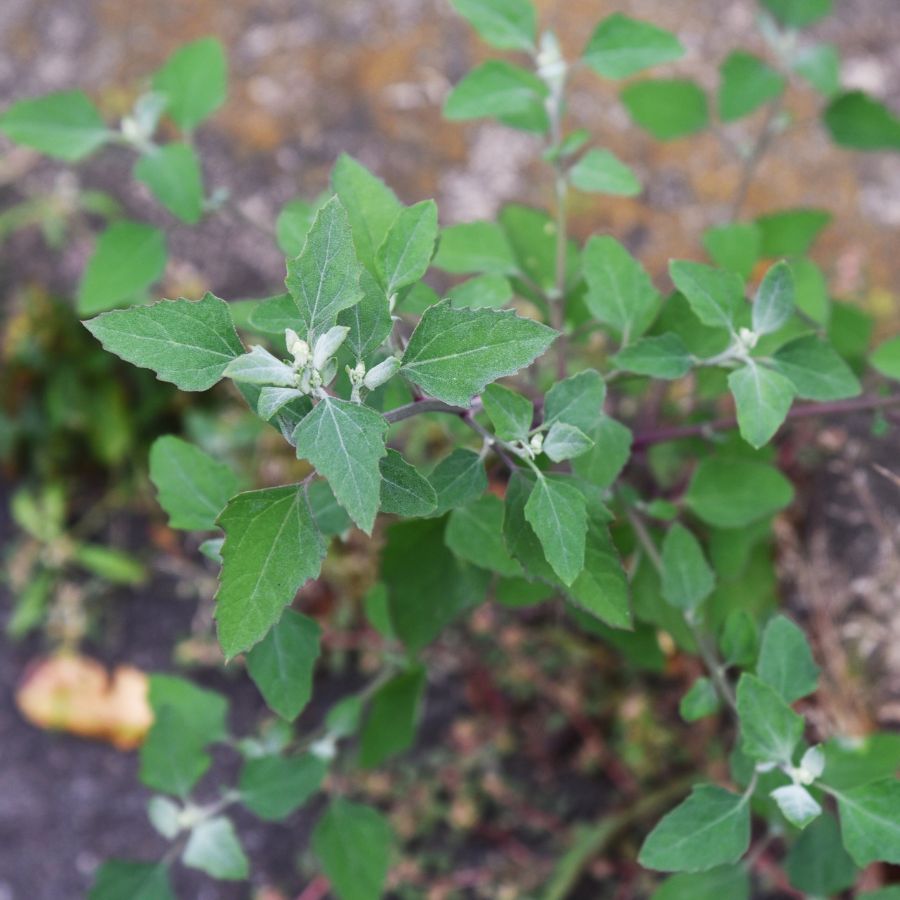
Knowing exactly what you’re picking is the most important part of safe foraging. Some edible plants have nearly identical toxic lookalikes, and a wrong guess can make you seriously sick.
Use more than one reliable source to confirm your ID, like field guides, apps, and trusted websites. Pay close attention to small details. Things like leaf shape, stem texture, and how the flowers or fruits are arranged all matter.
Not All Edible Plants Are Safe to Eat Whole
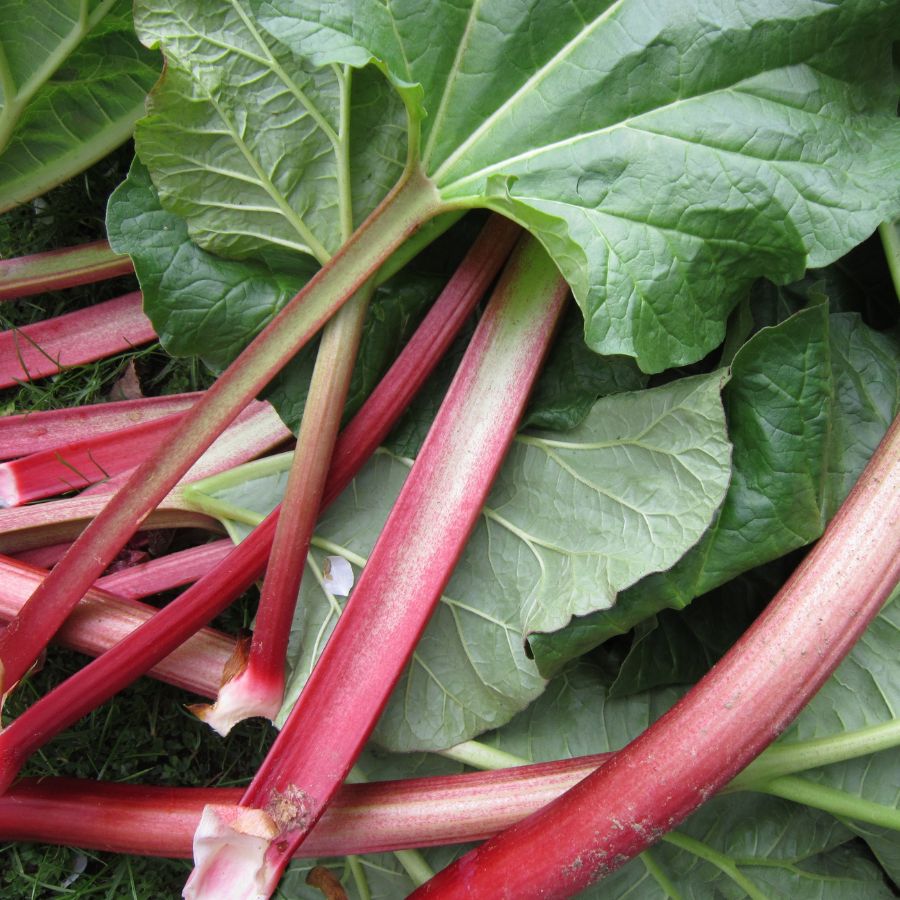
Just because a plant is edible doesn’t mean every part of it is safe. Some plants have leaves, stems, or seeds that can be toxic if eaten raw or prepared the wrong way.
For example, pokeweed is only safe when young and properly cooked, while elderberries need to be heated before eating. Rhubarb stems are fine, but the leaves are poisonous. Always look up which parts are edible and how they should be handled.
Avoid Foraging in Polluted or Contaminated Areas
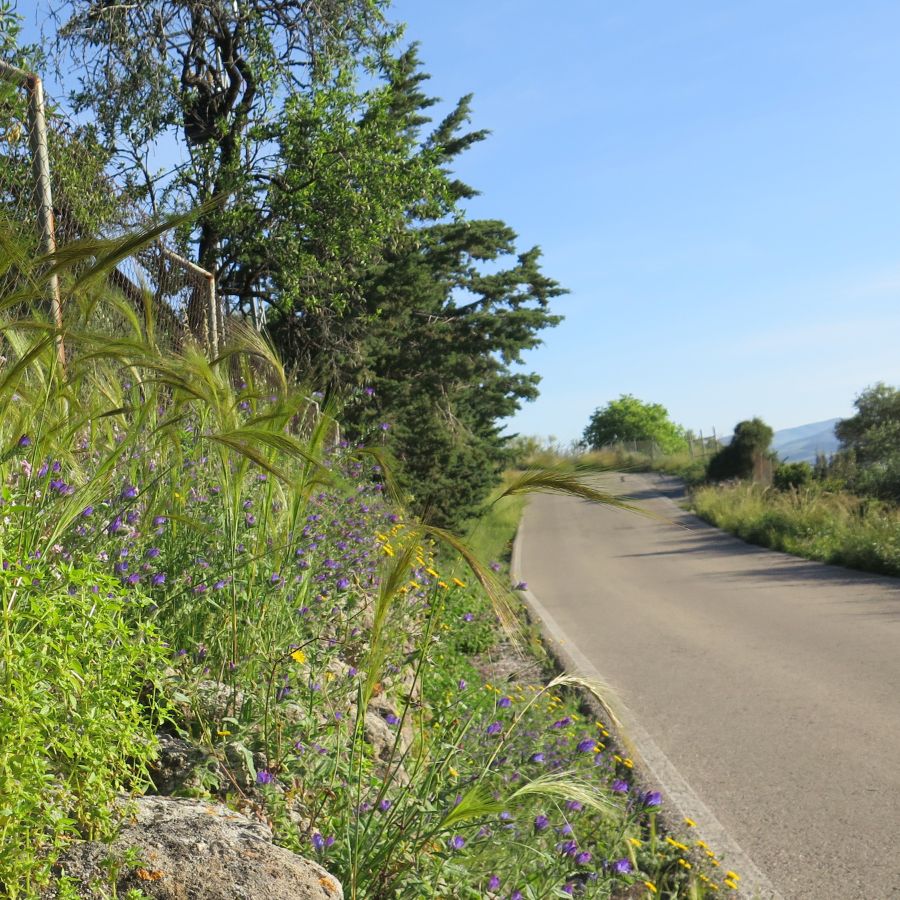
Where you forage matters just as much as what you pick. Plants growing near roads, buildings, or farmland might be coated in chemicals or growing in polluted soil.
Even safe plants can take in harmful substances from the air, water, or ground. Stick to clean, natural areas like forests, local parks that allow foraging, or your own yard when possible.
Don’t Harvest More Than What You Need
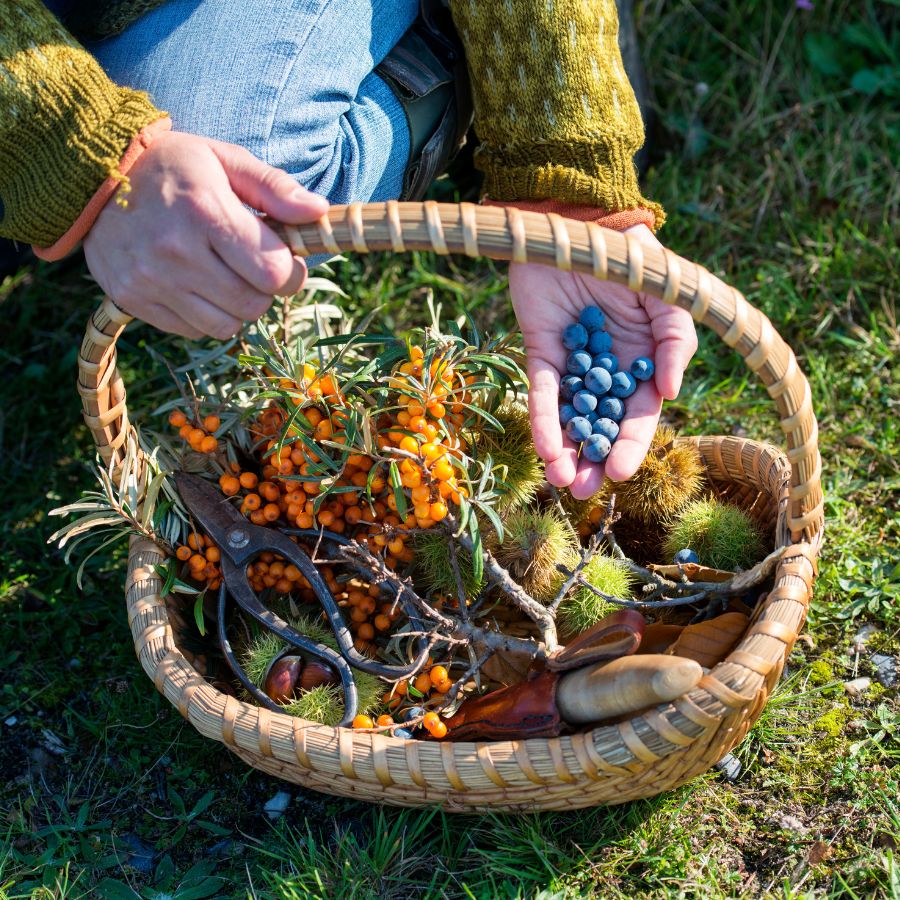
When you forage, take only what you plan to use. Overharvesting can hurt local plant populations and reduce future growth in that area.
Leaving plenty behind helps plants reproduce and supports wildlife that depends on them. It also ensures other foragers have a chance to enjoy the same resources.
Protect Yourself and Your Finds with Proper Foraging Gear
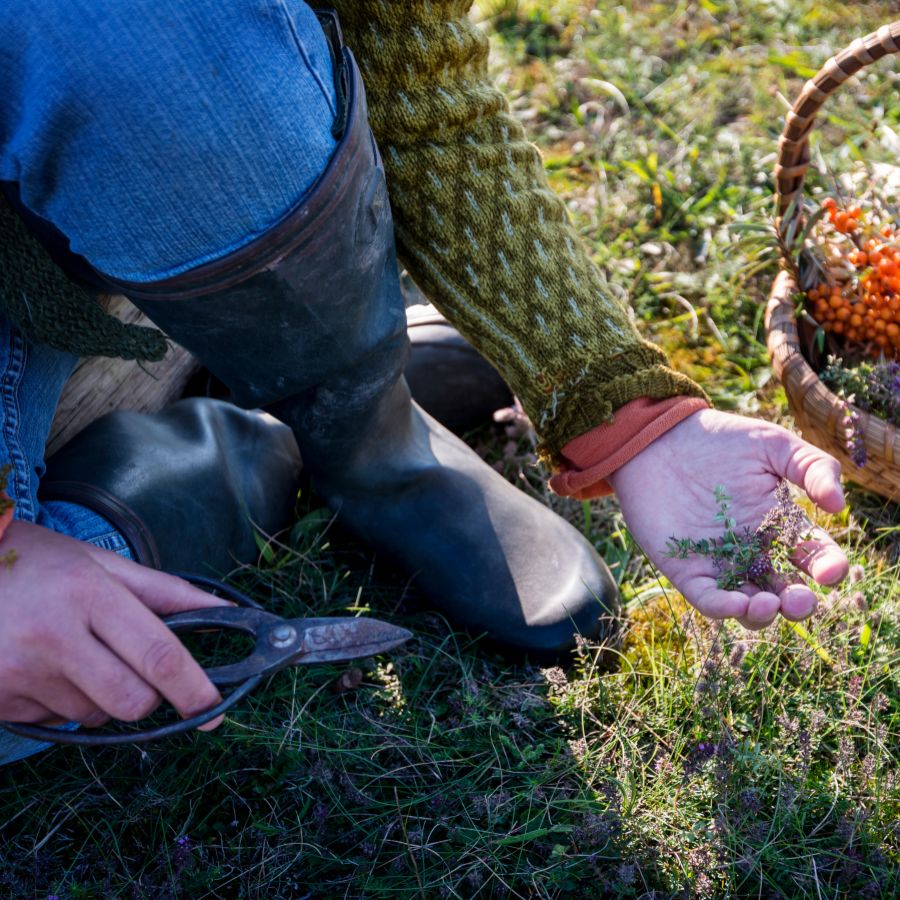
Having the right tools makes foraging easier and safer. Gloves protect your hands from irritants like stinging nettle, and a good knife or scissors lets you harvest cleanly without damaging the plant.
Use a basket or breathable bag to carry what you collect. Plastic bags hold too much moisture and can cause your greens to spoil before you get home.
This forager’s toolkit covers the essentials for any level of experience.
Watch for Allergic Reactions When Trying New Wild Foods

Even if a wild plant is safe to eat, your body might react to it in unexpected ways. It’s best to try a small amount first and wait to see how you feel.
Be extra careful with kids or anyone who has allergies. A plant that’s harmless for one person could cause a reaction in someone else.
Check Local Rules Before Foraging on Any Land
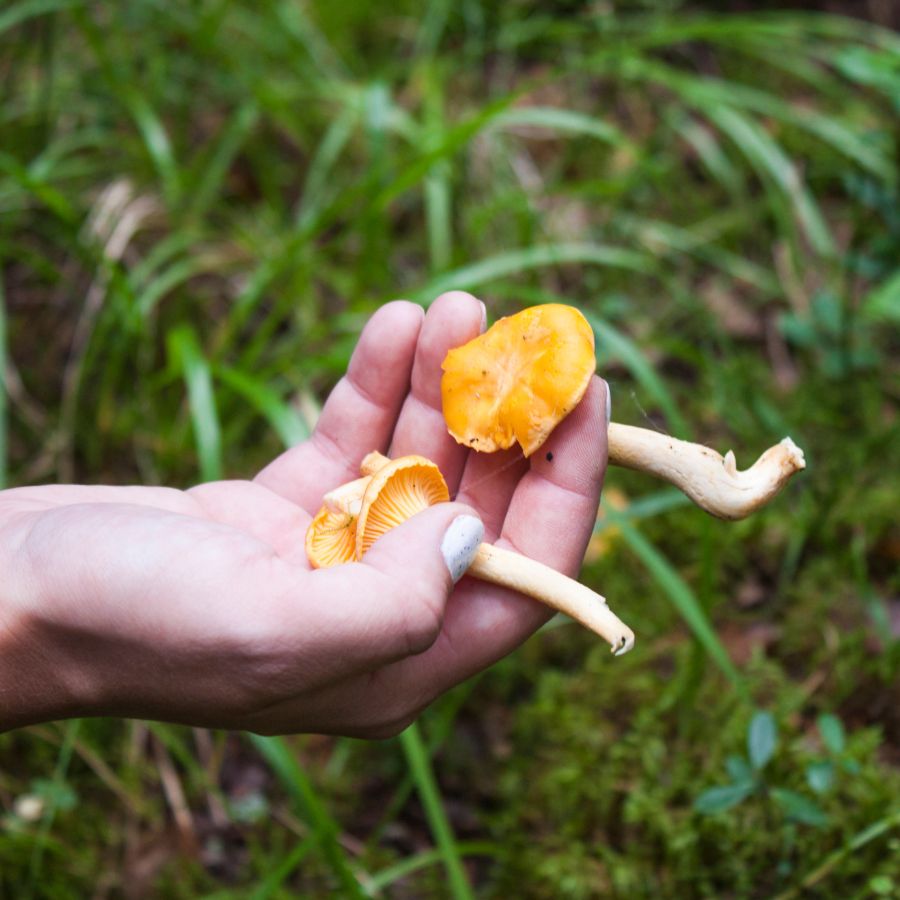
Before you start foraging, make sure you know the rules for the area you’re in. What’s allowed in one spot might be completely off-limits just a few miles away.
Some public lands permit limited foraging, while others, like national parks, usually don’t allow it at all. If you’re on private property, always get permission first.
Where to Find Forageables in the State
There is a range of foraging spots where edible plants grow naturally and often in abundance:
| Plant | Locations |
| American Basswood (Tilia americana) | Finger Lakes National Forest, Catskill Forest Preserve, Allegany State Park |
| American Beech (Fagus grandifolia) | Adirondack Forest Preserve, Catskill Forest Preserve, Schunnemunk State Park |
| American Hazelnut (Corylus americana) | Sterling Forest State Park, Montezuma National Wildlife Refuge, Clarence Fahnestock State Park |
| American Persimmon (Diospyros virginiana) | Staten Island Greenbelt, Prospect Park, Hempstead Lake State Park |
| American Plum (Prunus americana) | Albany Pine Bush Preserve, Montezuma National Wildlife Refuge, Clay Pit Ponds State Park Preserve |
| Bee Balm (Monarda didyma) | Minnewaska State Park Preserve, Allegany State Park, Sterling Forest State Park |
| Black Cherry (Prunus serotina) | Adirondack Forest Preserve, Finger Lakes National Forest, Catskill Forest Preserve |
| Black Raspberry (Rubus occidentalis) | Hudson Highlands State Park, Buttermilk Falls State Park, Rockefeller State Park Preserve |
| Black Walnut (Juglans nigra) | Greenbelt Nature Center, Thacher State Park, Cayuga Lake State Park |
| Blueberry (Vaccinium corymbosum, Vaccinium angustifolium) | Harriman State Park, Sterling Forest State Park, Catskill Forest Preserve |
| Burdock (Arctium minus) | Central Park, Prospect Park, Saratoga Spa State Park |
| Cattail (Typha latifolia, Typha angustifolia) | Montezuma National Wildlife Refuge, Black River Wild Forest, Nissequogue River State Park |
| Chickweed (Stellaria media) | Prospect Park, Central Park, Green Lakes State Park |
| Common Dandelion (Taraxacum officinale) | Almost all state parks including Bear Mountain State Park, Letchworth State Park, Green Lakes State Park |
| Common Milkweed (Asclepias syriaca) | Saratoga Spa State Park, Sterling Forest State Park, Finger Lakes National Forest |
| Common Plantain (Plantago major, Plantago lanceolata) | Widespread: Prospect Park, Central Park, Letchworth State Park |
| Common Blue Violet (Viola sororia) | Allegany State Park, Letchworth State Park, Rockefeller State Park Preserve |
| Curly Dock (Rumex crispus) | Central Park, Harriman State Park, Robert H. Treman State Park |
| Daylily (Hemerocallis fulva) | Green Lakes State Park, Inwood Hill Park, Minnewaska State Park Preserve |
| Elderberry (Sambucus nigra subsp. canadensis) | Adirondack Forest Preserve, Catskill Forest Preserve, Allegany State Park |
| Garlic Mustard (Alliaria petiolata) | Shaker Mountain Wild Forest, Mohonk Preserve, Rockefeller State Park Preserve |
| Groundnut (Apios americana) | Montezuma National Wildlife Refuge, Allegany State Park, Finger Lakes National Forest |
| Henbit (Lamium amplexicaule) | Central Park, Prospect Park, Saratoga Spa State Park |
| Highbush Cranberry (Viburnum trilobum) | Adirondack Forest Preserve, Montezuma National Wildlife Refuge, Thacher State Park |
| Orange Jewelweed (Impatiens capensis) | Minnewaska State Park Preserve, Hudson Highlands State Park, Allegany State Park |
| Lamb’s Quarters (Chenopodium album) | Central Park, Saratoga Spa State Park, Greenbelt Nature Center |
| Mayapple (Podophyllum peltatum) | Allegany State Park, Letchworth State Park, Sterling Forest State Park |
| Mulberry (Morus alba, Morus rubra) | Prospect Park, Central Park, Greenbelt Nature Center |
| Nannyberry (Viburnum lentago) | Catskill Forest Preserve, Allegany State Park, Finger Lakes National Forest |
| Northern Bayberry (Myrica pensylvanica) | Montauk Point State Park, Robert Moses State Park, Sunken Meadow State Park |
| Ostrich Fern (Matteuccia struthiopteris) | Adirondack Forest Preserve, Catskill Forest Preserve, Hudson Highlands State Park |
| Pawpaw (Asimina triloba) | Staten Island Greenbelt, Inwood Hill Park, Wave Hill Gardens (naturalized stands nearby) |
| Purslane (Portulaca oleracea) | Prospect Park, Central Park, Bear Mountain State Park |
| Red Clover (Trifolium pratense) | Green Lakes State Park, Allegany State Park, Buttermilk Falls State Park |
| Red Maple (Acer rubrum) | Adirondack Forest Preserve, Catskill Forest Preserve, Harriman State Park |
| Serviceberry (Amelanchier canadensis, Amelanchier arborea) | Prospect Park, Central Park, Rockefeller State Park Preserve |
| Sheep Sorrel (Rumex acetosella) | Minnewaska State Park Preserve, Hudson Highlands State Park, Allegany State Park |
| Shagbark Hickory (Carya ovata) | Adirondack Forest Preserve, Catskill Forest Preserve, Greenbelt Nature Center |
| Shepherd’s Purse (Capsella bursa-pastoris) | Central Park, Prospect Park, Green Lakes State Park |
| Spicebush (Lindera benzoin) | Sterling Forest State Park, Allegany State Park, Rockefeller State Park Preserve |
| Spring Beauty (Claytonia virginica) | Adirondack Forest Preserve, Catskill Forest Preserve, Hudson Highlands State Park |
| Staghorn Sumac (Rhus typhina) | Bear Mountain State Park, Hudson Highlands State Park, Allegany State Park |
| Wild Bergamot (Monarda fistulosa) | Finger Lakes National Forest, Minnewaska State Park Preserve, Allegany State Park |
| Wild Grape (Vitis riparia, Vitis labrusca) | Hudson Highlands State Park, Sterling Forest State Park, Allegany State Park |
| Wild Leek / Ramp (Allium tricoccum) | Shaker Mountain Wild Forest, Moose River Plains Wild Forest, Catskill Forest Preserve |
| Wild Onion (Allium canadense) | Prospect Park, Central Park, Sterling Forest State Park |
| Wild Strawberry (Fragaria virginiana) | Finger Lakes National Forest, Catskill Forest Preserve, Allegany State Park |
| Wintergreen (Gaultheria procumbens) | Adirondack Forest Preserve, Catskill Forest Preserve, Harriman State Park |
| Wood Sorrel (Oxalis stricta) | Central Park, Prospect Park, Allegany State Park |
Peak Foraging Seasons
Different edible plants grow at different times of year, depending on the season and weather. Timing your search makes all the difference.
Spring
Spring brings a fresh wave of wild edible plants as the ground thaws and new growth begins:
| Plant | Months | Best Weather Conditions |
| Common Blue Violet (Viola sororia) | April–June | Cool, moist |
| Garlic Mustard (Alliaria petiolata) | April–June | |
| Henbit (Lamium amplexicaule) | March–May | |
| Ostrich Fern (Matteuccia struthiopteris) | April–May | |
| Spring Beauty (Claytonia virginica) | April–May | |
| Wild Leek / Ramp (Allium tricoccum) | April–May | |
| Serviceberry (Amelanchier canadensis, Amelanchier arborea) | May–June | Warm, dry |
| Wild Strawberry (Fragaria virginiana) | May–June | Warm, moist |
| Burdock (Arctium minus) | March–May, September–November | Cool, moist |
| Chickweed (Stellaria media) | March–May, September–November | |
| Common Dandelion (Taraxacum officinale) | April–May, September–October | |
| Curly Dock (Rumex crispus) | March–May, September–November | |
| Shepherd’s Purse (Capsella bursa-pastoris) | April–June, September–November | |
| Spicebush (Lindera benzoin) | March–April, September–October | |
| Wild Onion (Allium canadense) | April–May, September–November | |
| Cattail (Typha latifolia, Typha angustifolia) | April–July | Warm, moist |
| Red Clover (Trifolium pratense) | May–August | Warm, sunny |
| Common Plantain (Plantago major, Plantago lanceolata) | April–October | Warm, moist |
| Sheep Sorrel (Rumex acetosella) | April–October | |
| Wood Sorrel (Oxalis stricta) | April–October |
Summer
Summer is a peak season for foraging, with fruits, flowers, and greens growing in full force:
| Plant | Months | Best Weather Conditions |
| American Basswood (Tilia americana) | June–July | Warm, mild, after rain |
| American Plum (Prunus americana) | July–August | Warm, sunny |
| Bee Balm (Monarda didyma) | June–August | Warm, humid |
| Black Cherry (Prunus serotina) | June–August | Warm, dry |
| Black Raspberry (Rubus occidentalis) | June–July | Warm, partly cloudy |
| Blueberry (Vaccinium corymbosum, Vaccinium angustifolium) | July–August | Warm, after rain |
| Common Milkweed (Asclepias syriaca) | June–August | Warm, sunny |
| Daylily (Hemerocallis fulva) | June–August | |
| Elderberry (Sambucus nigra subsp. canadensis) | July–August | |
| Lamb’s Quarters (Chenopodium album) | June–August | Warm, after rain |
| Mayapple (Podophyllum peltatum) | May–June | Warm, damp |
| Mulberry (Morus alba, Morus rubra) | June–July | Warm, dry |
| Orange Jewelweed (Impatiens capensis) | July–September | Warm, moist |
| Purslane (Portulaca oleracea) | June–September | Hot, dry |
| Staghorn Sumac (Rhus typhina) | July–August | Warm, dry |
| Wild Bergamot (Monarda fistulosa) | July–August | Warm, sunny |
| Wild Grape (Vitis riparia, Vitis labrusca) | August–October |
Fall
As temperatures drop, many edible plants shift underground or produce their last harvests:
| Plant | Months | Best Weather Conditions |
| American Beech (Fagus grandifolia) | September–November | Cool, dry |
| American Hazelnut (Corylus americana) | August–October | Mild, dry |
| American Persimmon (Diospyros virginiana) | October–November | Cool, after first frost |
| Black Walnut (Juglans nigra) | September–October | Mild, dry |
| Groundnut (Apios americana) | September–November | Cool, damp |
| Highbush Cranberry (Viburnum trilobum) | September–October | Cool, dry |
| Nannyberry (Viburnum lentago) | September–October | |
| Northern Bayberry (Myrica pensylvanica) | September–October | |
| Shagbark Hickory (Carya ovata) | September–October | |
| Pawpaw (Asimina triloba) | September–October | Mild, humid |
Winter
Winter foraging is limited but still possible, with hardy plants and preserved growth holding on through the cold:
| Plant | Months | Best Weather Conditions |
| Wintergreen (Gaultheria procumbens) | October–February | Cool to cold, dry |
| Red Maple (Acer rubrum) | February–March | Freezing nights, mild days |
One Final Disclaimer
The information provided in this article is for general informational and educational purposes only. Foraging for wild plants and mushrooms involves inherent risks. Some wild plants and mushrooms are toxic and can be easily mistaken for edible varieties.
Before ingesting anything, it should be identified with 100% certainty as edible by someone qualified and experienced in mushroom and plant identification, such as a professional mycologist or an expert forager. Misidentification can lead to serious illness or death.
All mushrooms and plants have the potential to cause severe adverse reactions in certain individuals, even death. If you are consuming foraged items, it is crucial to cook them thoroughly and properly and only eat a small portion to test for personal tolerance. Some people may have allergies or sensitivities to specific mushrooms and plants, even if they are considered safe for others.
Foraged items should always be fully cooked with proper instructions to ensure they are safe to eat. Many wild mushrooms and plants contain toxins and compounds that can be harmful if ingested.

